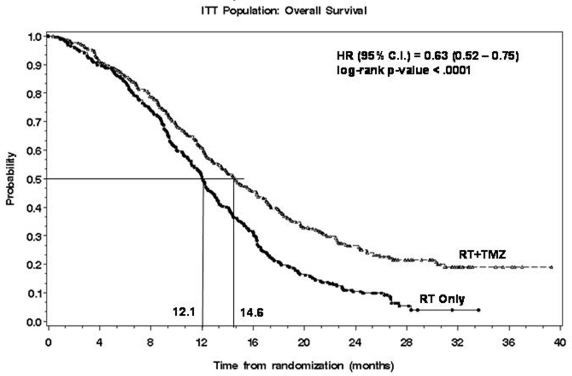Temozolomide by Accord Healthcare Inc. / Intas Pharmaceuticals Limited TEMOZOLOMIDE capsule
Temozolomide by
Drug Labeling and Warnings
Temozolomide by is a Prescription medication manufactured, distributed, or labeled by Accord Healthcare Inc., Intas Pharmaceuticals Limited . Drug facts, warnings, and ingredients follow.
Drug Details [pdf]
-
HIGHLIGHTS OF PRESCRIBING INFORMATION
These highlights do not include all the information needed to use TEMOZOLOMIDE CAPSULES safely and effectively. See full prescribing information for TEMOZOLOMIDE CAPSULES.
TEMOZOLOMIDE capsules, for oral use
Initial U.S. Approval: 1999INDICATIONS AND USAGE
Temozolomide is an alkylating drug indicated for the treatment of adult patients with:
DOSAGE AND ADMINISTRATION
- Newly Diagnosed GBM : 75 mg/m 2 for 42 days concomitant with focal radiotherapy followed by initial maintenance dose of 150 mg/m 2 once daily for Days 1 to 5 of a 28-day cycle of temozolomide capsules for 6 cycles. ( 2.1)
- Refractory Anaplastic Astrocytoma : Initial dose 150 mg/m 2 once daily for 5 consecutive days per 28-day treatment cycle. ( 2.1)
DOSAGE FORMS AND STRENGTHS
- 5-mg, 20-mg, 100-mg, 140-mg, 180-mg, and 250-mg capsules. ( 3)
CONTRAINDICATIONS
- Known hypersensitivity to any temozolomide capsules component or to dacarbazine (DTIC). ( 4.1)
WARNINGS AND PRECAUTIONS
- Myelosuppression — monitor Absolute Neutrophil Count (ANC) and platelet count prior to dosing and throughout treatment. Geriatric patients and women have a higher risk of developing myelosuppression. ( 5.1)
- Cases of myelodysplastic syndrome and secondary malignancies, including myeloid leukemia, have been observed. ( 5.2)
- Pneumocystis pneumonia (PCP) – PCP prophylaxis required for all patients receiving concomitant temozolomide and radiotherapy for the 42-day regimen for the treatment of newly diagnosed glioblastoma multiforme. ( 5.3)
- All patients, particularly those receiving steroids, should be observed closely for the development of lymphopenia and PCP. ( 5.4)
- Complete blood counts should be obtained throughout the treatment course as specified. ( 5.4)
- Hepatotoxicity – fatal and severe hepatotoxicity have been reported. Perform liver function tests at baseline, midway through the first cycle, prior to each subsequent cycle, and approximately two to four weeks after the last dose of temozolomide ( 5.5)
- Fetal harm can occur when administered to a pregnant woman. Women should be advised to avoid becoming pregnant when receiving temozolomide. ( 5.6)
ADVERSE REACTIONS
- The most common adverse reactions (≥10% incidence) are: alopecia, fatigue, nausea, vomiting, headache, constipation, anorexia, convulsions, rash, hemiparesis, diarrhea, asthenia, fever, dizziness, coordination abnormal, viral infection, amnesia, and insomnia. ( 6.1)
- The most common Grade 3 to 4 hematologic laboratory abnormalities (≥10% incidence) that have developed during treatment with temozolomide are: lymphopenia, thrombocytopenia, neutropenia, and leukopenia. ( 6.1)
- Allergic reactions have also been reported. ( 6)
To report SUSPECTED ADVERSE REACTIONS, contact Accord Healthcare Inc., at 1-866-941-7875 or www.accordhealthcare.us or FDA at 1-800-FDA-1088 or www.fda.gov/medwatch.
DRUG INTERACTIONS
- Valproic acid: decreases oral clearance of temozolomide. ( 7.1)
USE IN SPECIFIC POPULATIONS
See 17 for PATIENT COUNSELING INFORMATION.
Revised: 7/2018
-
Table of Contents
FULL PRESCRIBING INFORMATION: CONTENTS*
1 INDICATIONS AND USAGE
1.1 Newly Diagnosed Glioblastoma Multiforme
1.2 Refractory Anaplastic Astrocytoma
2 DOSAGE AND ADMINISTRATION
2.1 Recommended Dosing and Dose Modification Guidelines
2.2 Preparation and Administration
3 DOSAGE FORMS AND STRENGTHS
4 CONTRAINDICATIONS
4.1 Hypersensitivity
5 WARNINGS AND PRECAUTIONS
5.1 Myelosuppression
5.2 Myelodysplastic Syndrome
5.3 Pneumocystis Pneumonia
5.4 Laboratory Tests
5.5 Hepatotoxicity
5.6 Use in Pregnancy
6 ADVERSE REACTIONS
6.1 Clinical Trials Experience
6.2 Postmarketing Experience
7 DRUG INTERACTIONS
7.1 Valproic Acid
8 USE IN SPECIFIC POPULATIONS
8.1 Pregnancy
8.3 Nursing Mothers
8.4 Pediatric Use
8.5 Geriatric Use
8.6 Renal Impairment
8.7 Hepatic Impairment
10 OVERDOSAGE
11 DESCRIPTION
12 CLINICAL PHARMACOLOGY
12.1 Mechanism of Action
12.3 Pharmacokinetics
13 NONCLINICAL TOXICOLOGY
13.1 Carcinogenesis, Mutagenesis, Impairment of Fertility
13.2 Animal Toxicology and/or Pharmacology
14 CLINICAL STUDIES
14.1 Newly Diagnosed Glioblastoma Multiforme
14.2 Refractory Anaplastic Astrocytoma
15 REFERENCES
16 HOW SUPPLIED/STORAGE AND HANDLING
16.1 Safe Handling and Disposal
16.2 How Supplied
16.3 Storage
17 PATIENT COUNSELING INFORMATION
17.1 Information for the Patient
- * Sections or subsections omitted from the full prescribing information are not listed.
- 1 INDICATIONS AND USAGE
-
2 DOSAGE AND ADMINISTRATION
2.1 Recommended Dosing and Dose Modification Guidelines
Dosage of temozolomide capsules must be adjusted according to nadir neutrophil and platelet counts in the previous cycle and the neutrophil and platelet counts at the time of initiating the next cycle. For temozolomide capsules dosage calculations based on body surface area (BSA) see Table 5. For suggested capsule combinations on a daily dose see Table 6.
Patients with Newly Diagnosed High Grade Glioma:
Concomitant Phase:
Temozolomide capsule is administered at 75 mg/m 2 daily for 42 days concomitant with focal radiotherapy (60 Gy administered in 30 fractions) followed by maintenance temozolomide capsules for 6 cycles. Focal RT includes the tumor bed or resection site with a 2- to 3-cm margin. No dose reductions are recommended during the concomitant phase; however, dose interruptions or discontinuation may occur based on toxicity. The temozolomide capsules dose should be continued throughout the 42-day concomitant period up to 49 days if all of the following conditions are met: absolute neutrophil count greater than or equal to 1.5 x 10 9 /L, platelet count greater than or equal to 100 x 10 9/L, common toxicity criteria (CTC) nonhematological toxicity less than or equal to Grade 1 (except for alopecia, nausea, and vomiting). During treatment a complete blood count should be obtained weekly. Temozolomide dosing should be interrupted or discontinued during concomitant phase according to the hematological and nonhematological toxicity criteria as noted in Table 1. Pneumocystis pneumonia (PCP) prophylaxis is required during the concomitant administration of temozolomide capsules and radiotherapy, and should be continued in patients who develop lymphocytopenia until recovery from lymphocytopenia (CTC Grade less than or equal to 1).
TABLE 1: Temozolomide Dosing Interruption or Discontinuation During Concomitant Radiotherapy and Temozolomide Toxicity TMZ Interruption * TMZ Discontinuation TMZ=temozolomide; CTC=Common Toxicity Criteria. - * Treatment with concomitant TMZ could be continued when all of the following conditions were met: absolute neutrophil count greater than or equal to 1.5 x 10 9/L; platelet count greater than or equal to 100 x 10 9/L; CTC nonhematological toxicity less than or equal to Grade 1 (except for alopecia, nausea, vomiting).
Absolute Neutrophil Count greater than or equal to 0.5 and less than 1.5 × 10 9/L less than 0.5 × 10 9/L Platelet Count greater than or equal to 10 and less than 100 × 10 9/L less than 10 × 10 9/L CTC Nonhematological Toxicity
(except for alopecia, nausea, vomiting)CTC Grade 2 CTC Grade 3 or 4 Maintenance Phase:
Cycle 1:
Four weeks after completing the temozolomide +RT phase, temozolomide capsule is administered for an additional 6 cycles of maintenance treatment. Dosage in Cycle 1 (maintenance) is 150 mg/m 2 once daily for 5 days followed by 23 days without treatment.
Cycles 2 to 6:
At the start of Cycle 2, the dose can be escalated to 200 mg/m 2, if the CTC nonhematologic toxicity for Cycle 1 is Grade less than or equal to 2 (except for alopecia, nausea, and vomiting), absolute neutrophil count (ANC) is greater than or equal to 1.5 x 10 9/L, and the platelet count is greater than or equal to 100 x 10 9/L. The dose remains at 200 mg/m 2 per day for the first 5 days of each subsequent cycle except if toxicity occurs. If the dose was not escalated at Cycle 2, escalation should not be done in subsequent cycles.
Dose Reduction or Discontinuation During Maintenance:
Dose reductions during the maintenance phase should be applied according to Tables 2 and 3.
During treatment, a complete blood count should be obtained on Day 22 (21 days after the first dose of temozolomide capsules) or within 48 hours of that day, and weekly until the ANC is above 1.5 x 10 9/L (1500/μL) and the platelet count exceeds 100 x 10 9/L (100,000/μL). The next cycle of temozolomide capsules should not be started until the ANC and platelet count exceed these levels. Dose reductions during the next cycle should be based on the lowest blood counts and worst nonhematologic toxicity during the previous cycle. Dose reductions or discontinuations during the maintenance phase should be applied according to Tables 2 and 3.
TABLE 2: Temozolomide Dose Levels for Maintenance Treatment Dose Level Dose (mg/m 2/day) Remarks −1 100 Reduction for prior toxicity 0 150 Dose during Cycle 1 1 200 Dose during Cycles 2 to 6 in absence of toxicity TABLE 3: Temozolomide Dose Reduction or Discontinuation During Maintenance Treatment Toxicity Reduce TMZ by 1 Dose Level * Discontinue TMZ TMZ=temozolomide; CTC=Common Toxicity Criteria. - * TMZ dose levels are listed in Table 2.
- † TMZ is to be discontinued if dose reduction to less than 100 mg/m 2 is required or if the same Grade 3 nonhematological toxicity (except for alopecia, nausea, vomiting) recurs after dose reduction.
Absolute Neutrophil Count less than 1.0 x 10 9/L See footnote † Platelet Count less than 50 x 10 9/L See footnote † CTC Nonhematological Toxicity
(except for alopecia, nausea, vomiting)CTC Grade 3 CTC Grade 4 † Patients with Refractory Anaplastic Astrocytoma:
For adults the initial dose is 150 mg/m 2 once daily for 5 consecutive days per 28-day treatment cycle. For adult patients, if both the nadir and day of dosing (Day 29, Day 1 of next cycle) ANC are greater than or equal to 1.5 x 10 9/L (1500/μL) and both the nadir and Day 29, Day 1 of next cycle platelet counts are greater than or equal to 100 x 10 9/L (100,000/μL), the temozolomide capsules dose may be increased to 200 mg/m 2/day for 5 consecutive days per 28-day treatment cycle. During treatment, a complete blood count should be obtained on Day 22 (21 days after the first dose) or within 48 hours of that day, and weekly until the ANC is above 1.5 x 10 9/L (1500/μL) and the platelet count exceeds 100 x 10 9/L (100,000/μL). The next cycle of temozolomide capsules should not be started until the ANC and platelet count exceed these levels. If the ANC falls to less than 1.0 x 10 9/L (1000/μL) or the platelet count is less than 50 x 10 9/L (50,000/μL) during any cycle, the next cycle should be reduced by 50 mg/m 2, but not below 100 mg/m 2, the lowest recommended dose (see Table 4). Temozolomide capsules therapy can be continued until disease progression. In the clinical trial, treatment could be continued for a maximum of 2 years, but the optimum duration of therapy is not known.
TABLE 4: Dosing Modification Table 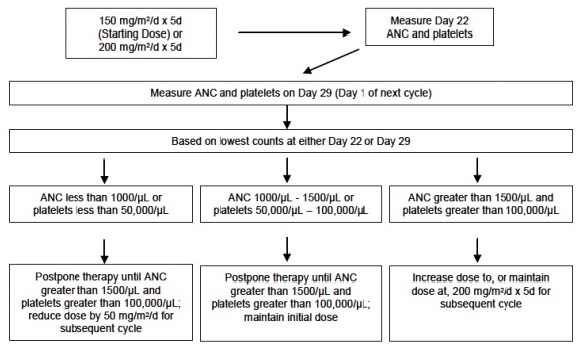
TABLE 5: Daily Dose Calculations by Body Surface Area (BSA) Total BSA
(m 2)75 mg/m 2
(mg daily)150 mg/m 2
(mg daily)200 mg/m 2
(mg daily)1.0 75 150 200 1.1 82.5 165 220 1.2 90 180 240 1.3 97.5 195 260 1.4 105 210 280 1.5 112.5 225 300 1.6 120 240 320 1.7 127.5 255 340 1.8 135 270 360 1.9 142.5 285 380 2.0 150 300 400 2.1 157.5 315 420 2.2 165 330 440 2.3 172.5 345 460 2.4 180 360 480 2.5 187.5 375 500 TABLE 6: Suggested Capsule Combinations Based on Daily Dose in Adults Number of Daily Capsules by Strength (mg) Total Daily Dose (mg) 250 mg 180 mg 140 mg 100 mg 20 mg 5 mg 75 0 0 0 0 3 3 82.5 0 0 0 0 4 0 90 0 0 0 0 4 2 97.5 0 0 0 1 0 0 105 0 0 0 1 0 1 112.5 0 0 0 1 0 2 120 0 0 0 1 1 0 127.5 0 0 0 1 1 1 135 0 0 0 1 1 3 142.5 0 0 1 0 0 0 150 0 0 1 0 0 2 157.5 0 0 1 0 1 0 165 0 0 1 0 1 1 172.5 0 0 1 0 1 2 180 0 1 0 0 0 0 187.5 0 1 0 0 0 1 195 0 1 0 0 0 3 200 0 1 0 0 1 0 210 0 0 0 2 0 2 220 0 0 0 2 1 0 225 0 0 0 2 1 1 240 0 0 1 1 0 0 255 1 0 0 0 0 1 260 1 0 0 0 0 2 270 1 0 0 0 1 0 280 0 0 2 0 0 0 285 0 0 2 0 0 1 300 0 0 0 3 0 0 315 0 0 0 3 0 3 320 0 1 1 0 0 0 330 0 1 1 0 0 2 340 0 1 1 0 1 0 345 0 1 1 0 1 1 360 0 2 0 0 0 0 375 0 2 0 0 0 3 380 0 1 0 2 0 0 400 0 0 0 4 0 0 420 0 0 3 0 0 0 440 0 0 3 0 1 0 460 0 2 0 1 0 0 480 0 1 0 3 0 0 500 2 0 0 0 0 0 2.2 Preparation and Administration
Temozolomide Capsules:
In clinical trials, temozolomide capsules was administered under both fasting and nonfasting conditions; however, absorption is affected by food [see Clinical Pharmacology (12.3)] , and consistency of administration with respect to food is recommended. There are no dietary restrictions with temozolomide capsules. To reduce nausea and vomiting, temozolomide capsules should be taken on an empty stomach. Bedtime administration may be advised. Antiemetic therapy may be administered prior to and/or following administration of temozolomide.
Temozolomide capsules should not be opened or chewed. They should be swallowed whole with a glass of water.
If capsules are accidentally opened or damaged, precautions should be taken to avoid inhalation or contact with the skin or mucous membranes [see How Supplied/Storage and Handling (16.1)].
-
3 DOSAGE FORMS AND STRENGTHS
- Temozolomide capsules for oral administration
- 5-mg capsules have white bodies with green caps. The capsule body is imprinted with '5'. The cap is imprinted with 'TMZ'.
- 20-mg capsules have white bodies with yellow caps. The capsule body is imprinted with '20'. The cap is imprinted with 'TMZ'.
- 100-mg capsules have white bodies with pink caps. The capsule body is imprinted with '100'. The cap is imprinted with 'TMZ'.
- 140-mg capsules have white bodies with transparent blue caps. The capsule body is imprinted with '140'. The cap is imprinted with 'TMZ'.
- 180-mg capsules have white bodies with maroon caps. The capsule body is imprinted with '180'. The cap is imprinted with 'TMZ'.
- 250-mg capsules have white bodies with white caps. The capsule body is imprinted with '250'. The cap is imprinted with 'TMZ'.
- Temozolomide capsules for oral administration
-
4 CONTRAINDICATIONS
4.1 Hypersensitivity
Temozolomide capsule is contraindicated in patients who have a history of hypersensitivity reaction (such as urticaria, allergic reaction including anaphylaxis, toxic epidermal necrolysis, and Stevens-Johnson syndrome) to any of its components. Temozolomide capsule is also contraindicated in patients who have a history of hypersensitivity to dacarbazine (DTIC), since both drugs are metabolized to 5-(3-methyltriazen-1-yl)-imidazole-4-carboxamide (MTIC).
-
5 WARNINGS AND PRECAUTIONS
5.1 Myelosuppression
Patients treated with temozolomide may experience myelosuppression, including prolonged pancytopenia, which may result in aplastic anemia, which in some cases has resulted in a fatal outcome. In some cases, exposure to concomitant medications associated with aplastic anemia, including carbamazepine, phenytoin, and sulfamethoxazole/trimethoprim, complicates assessment. Prior to dosing, patients must have an absolute neutrophil count (ANC) greater than or equal to 1.5 x 10 9/L and a platelet count greater than or equal to 100 x 10 9/L. A complete blood count should be obtained on Day 22 (21 days after the first dose) or within 48 hours of that day, and weekly until the ANC is above 1.5 x 10 9/L and platelet count exceeds 100 x 10 9/L. Geriatric patients and women have been shown in clinical trials to have a higher risk of developing myelosuppression.
5.2 Myelodysplastic Syndrome
Cases of myelodysplastic syndrome and secondary malignancies, including myeloid leukemia, have been observed.
5.3 Pneumocystis Pneumonia
For treatment of newly diagnosed glioblastoma multiforme: Prophylaxis against Pneumocystis pneumonia (PCP) is required for all patients receiving concomitant temozolomide and radiotherapy for the 42-day regimen.
There may be a higher occurrence of PCP when temozolomide is administered during a longer dosing regimen. However, all patients receiving temozolomide, particularly patients receiving steroids, should be observed closely for the development of PCP regardless of the regimen.
5.4 Laboratory Tests
For the concomitant treatment phase with RT, a complete blood count should be obtained prior to initiation of treatment and weekly during treatment.
For the 28-day treatment cycles, a complete blood count should be obtained prior to treatment on Day 1 and on Day 22 (21 days after the first dose) of each cycle. Blood counts should be performed weekly until recovery if the ANC falls below 1.5 x 10 9/L and the platelet count falls below 100 x 10 9/L [see Dosage and Administration (2.1)].
5.5 Hepatotoxicity
Fatal and severe hepatotoxicity have been reported in patients receiving temozolomide. Perform liver function tests at baseline, midway through the first cycle, prior to each subsequent cycle, and approximately two to four weeks after the last dose of temozolomide.
5.6 Use in Pregnancy
Temozolomide can cause fetal harm when administered to a pregnant woman. Administration of temozolomide to rats and rabbits during organogenesis at 0.38 and 0.75 times the maximum recommended human dose (75 and 150 mg/m 2), respectively, caused numerous fetal malformations of the external organs, soft tissues, and skeleton in both species [see Use in Specific Populations (8.1)] .
-
6 ADVERSE REACTIONS
6.1 Clinical Trials Experience
Because clinical trials are conducted under widely varying conditions, adverse reaction rates observed in the clinical trials of a drug cannot be directly compared to rates in the clinical trials of another drug and may not reflect the rates observed in practice.
Newly Diagnosed Glioblastoma Multiforme:
During the concomitant phase (temozolomide+radiotherapy), adverse reactions including thrombocytopenia, nausea, vomiting, anorexia, and constipation were more frequent in the temozolomide+RT arm. The incidence of other adverse reactions was comparable in the two arms. The most common adverse reactions across the cumulative temozolomide experience were alopecia, nausea, vomiting, anorexia, headache, and constipation (see Table 7). Forty-nine percent (49%) of patients treated with temozolomide reported one or more severe or life-threatening reactions, most commonly fatigue (13%), convulsions (6%), headache (5%), and thrombocytopenia (5%). Overall, the pattern of reactions during the maintenance phase was consistent with the known safety profile of temozolomide.
TABLE 7: Number (%) of Patients with Adverse Reactions: All and Severe/Life Threatening (Incidence of 5% or Greater) RT+TMZ=radiotherapy plus temozolomide; NOS=not otherwise specified.
Note: Grade 5 (fatal) adverse reactions are included in the Grade ≥3 column.- * One patient who was randomized to RT only arm received RT+ temozolomide.
Concomitant Phase
RT Alone
(n = 285)Concomitant Phase
RT + TMZ
(n = 288) *Maintenance Phase
TMZ
(n = 224)All Grade ≥3 All Grade ≥3 All Grade ≥3 Subjects Reporting any Adverse Reaction 258 (91) 74 (26) 266 (92) 80 (28) 206 (92) 82 (37) Body as a Whole – General Disorders Anorexia 25 (9) 1 (<1) 56 (19) 2 (1) 61 (27) 3 (1) Dizziness 10 (4) 0 12 (4) 2 (1) 12 (5) 0 Fatigue 139 (49) 15 (5) 156 (54) 19 (7) 137 (61) 20 (9) Headache 49 (17) 11 (4) 56 (19) 5 (2) 51 (23) 9 (4) Weakness 9 (3) 3 (1) 10 (3) 5 (2) 16 (7) 4 (2) Central and Peripheral Nervous System Disorders Confusion 12 (4) 6 (2) 11 (4) 4 (1) 12 (5) 4 (2) Convulsions 20 (7) 9 (3) 17 (6) 10 (3) 25 (11) 7 (3) Memory Impairment 12 (4) 1 (<1) 8 (3) 1 (<1) 16 (7) 2 (1) Disorders of the Eye Vision Blurred 25 (9) 4 (1) 26 (9) 2 (1) 17 (8) 0 Disorders of the Immune System Allergic Reaction 7 (2) 1 (<1) 13 (5) 0 6 (3) 0 Gastrointestinal System Disorders Abdominal Pain 2 (1) 0 7 (2) 1 (<1) 11 (5) 1 (<1) Constipation 18 (6) 0 53 (18) 3 (1) 49 (22) 0 Diarrhea 9 (3) 0 18 (6) 0 23 (10) 2 (1) Nausea 45 (16) 1 (< 1) 105 (36) 2 (1) 110 (49) 3 (1) Stomatitis 14 (5) 1 (< 1) 19 (7) 0 20 (9) 3 (1) Vomiting 16 (6) 1 (< 1) 57 (20) 1 (<1) 66 (29) 4 (2) Injury and Poisoning Radiation Injury NOS 11 (4) 1 (<1) 20 (7) 0 5 (2) 0 Musculoskeletal System Disorders Arthralgia 2 (1) 0 7 (2) 1 (<1) 14 (6) 0 Platelet, Bleeding and Clotting Disorders Thrombocytopenia 3 (1) 0 11 (4) 8 (3) 19 (8) 8 (4) Psychiatric Disorders Insomnia 9 (3) 1 (<1) 14 (5) 0 9 (4) 0 Respiratory System Disorders Coughing 3 (1) 0 15 (5) 2 (1) 19 (8) 1 (<1) Dyspnea 9 (3) 4 (1) 11 (4) 5 (2) 12 (5) 1 (<1) Skin and Subcutaneous Tissue Disorders Alopecia 179 (63) 0 199 (69) 0 124 (55) 0 Dry Skin 6 (2) 0 7 (2) 0 11 (5) 1 (<1) Erythema 15 (5) 0 14 (5) 0 2 (1) 0 Pruritus 4 (1) 0 11 (4) 0 11 (5) 0 Rash 42 (15) 0 56 (19) 3 (1) 29 (13) 3 (1) Special Senses Other, Disorders Taste Perversion 6 (2) 0 18 (6) 0 11 (5) 0 Myelosuppression (neutropenia and thrombocytopenia), which is a known dose-limiting toxicity for most cytotoxic agents, including temozolomide, was observed. When laboratory abnormalities and adverse reactions were combined, Grade 3 or Grade 4 neutrophil abnormalities including neutropenic reactions were observed in 8% of the patients, and Grade 3 or Grade 4 platelet abnormalities, including thrombocytopenic reactions, were observed in 14% of the patients treated with temozolomide.
Refractory Anaplastic Astrocytoma:
Tables 8 and 9 show the incidence of adverse reactions in the 158 patients in the anaplastic astrocytoma study for whom data are available. In the absence of a control group, it is not clear in many cases whether these reactions should be attributed to temozolomide or the patients' underlying conditions, but nausea, vomiting, fatigue, and hematologic effects appear to be clearly drug-related. The most frequently occurring adverse reactions were nausea, vomiting, headache, and fatigue. The adverse reactions were usually NCI Common Toxicity Criteria (CTC) Grade 1 or 2 (mild to moderate in severity) and were self-limiting, with nausea and vomiting readily controlled with antiemetics. The incidence of severe nausea and vomiting (CTC Grade 3 or 4) was 10% and 6%, respectively. Myelosuppression (thrombocytopenia and neutropenia) was the dose-limiting adverse reaction. It usually occurred within the first few cycles of therapy and was not cumulative.
Myelosuppression occurred late in the treatment cycle and returned to normal, on average, within 14 days of nadir counts. The median nadirs occurred at 26 days for platelets (range: 21 to 40 days) and 28 days for neutrophils (range: 1 to 44 days). Only 14% (22/158) of patients had a neutrophil nadir and 20% (32/158) of patients had a platelet nadir, which may have delayed the start of the next cycle. Less than 10% of patients required hospitalization, blood transfusion, or discontinuation of therapy due to myelosuppression.
In clinical trial experience with 110 to 111 women and 169 to 174 men (depending on measurements), there were higher rates of Grade 4 neutropenia (ANC less than 500 cells/μL) and thrombocytopenia (less than 20,000 cells/μL) in women than men in the first cycle of therapy (12% vs. 5% and 9% vs. 3%, respectively).
In the entire safety database for which hematologic data exist (N=932), 7% (4/61) and 9.5% (6/63) of patients over age 70 experienced Grade 4 neutropenia or thrombocytopenia in the first cycle, respectively. For patients less than or equal to age 70, 7% (62/871) and 5.5% (48/879) experienced Grade 4 neutropenia or thrombocytopenia in the first cycle, respectively. Pancytopenia, leukopenia, and anemia have also been reported.
TABLE 8: Adverse Reactions in the Anaplastic Astrocytoma Trial in Adults (≥ 5%) - * Blurred vision; visual deficit; vision changes; vision troubles
No. (%) of Temozolomide Patients (N = 158) All Reactions Grade 3/4 Any Adverse Reaction 153 (97) 79 (50) Body as a Whole Headache 65 (41) 10 (6) Fatigue 54 (34) 7 (4) Asthenia 20 (13) 9 (6) Fever 21 (13) 3 (2) Back pain 12 (8) 4 (3) Cardiovascular Edema peripheral 17 (11) 1 (1) Central and Peripheral Nervous System Convulsions 36 (23) 8 (5) Hemiparesis 29 (18) 10 (6) Dizziness 19 (12) 1 (1) Coordination abnormal 17 (11) 2 (1) Amnesia 16 (10) 6 (4) Insomnia 16 (10) 0 Paresthesia 15 (9) 1 (1) Somnolence 15 (9) 5 (3) Paresis 13 (8) 4 (3) Urinary incontinence 13 (8) 3 (2) Ataxia 12 (8) 3 (2) Dysphasia 11 (7) 1 (1) Convulsions local 9 (6) 0 Gait abnormal 9 (6) 1 (1) Confusion 8 (5) 0 Endocrine Adrenal hypercorticism 13 (8) 0 Gastrointestinal System Nausea 84 (53) 16 (10) Vomiting 66 (42) 10 (6) Constipation 52 (33) 1 (1) Diarrhea 25 (16) 3 (2) Abdominal pain 14 (9) 2 (1) Anorexia 14 (9) 1 (1) Metabolic Weight increase 8 (5) 0 Musculoskeletal System Myalgia 8 (5) Psychiatric Disorders Anxiety 11 (7) 1 (1) Depression 10 (6) 0 Reproductive Disorders Breast pain, female 4 (6) Resistance Mechanism Disorders Infection viral 17 (11) 0 Respiratory System Upper respiratory tract infection 13 (8) 0 Pharyngitis 12 (8) 0 Sinusitis 10 (6) 0 Coughing 8 (5) 0 Skin and Appendages Rash 13 (8) 0 Pruritus 12 (8) 2 (1) Urinary System Urinary tract infection 12 (8) 0 Micturition increased frequency 9 (6) 0 Vision Diplopia 8 (5) 0 Vision abnormal * 8 (5) 6.2 Postmarketing Experience
The following adverse reactions have been identified during postapproval use of temozolomide. Because these reactions are reported voluntarily from a population of uncertain size, it is not always possible to reliably estimate their frequency or establish a causal relationship to the drug exposure.
Dermatologic disorders: Toxic epidermal necrolysis and Stevens-Johnson syndrome
Immune system disorders: Allergic reactions, including anaphylaxis. Erythema multiforme, which resolved after discontinuation of temozolomide capsules and, in some cases, recurred upon rechallenge.
Hematopoietic disorders: Prolonged pancytopenia, which may result in aplastic anemia and fatal outcomes [ see Warnings and Precautions (5.1)].
Hepatobiliary disorders: Fatal and severe hepatotoxicity, elevation of liver enzymes, hyperbilirubinemia, cholestasis, and hepatitis [ see Warnings and Precautions (5.5)].
Infections and infestations: Serious opportunistic infections, including some cases with fatal outcomes, can occur with bacterial, viral (primary and reactivated), fungal, and protozoan organisms.
Pulmonary disorders: Interstitial pneumonitis, pneumonitis, alveolitis, and pulmonary fibrosis.
Endocrine disorders: Diabetes insipidus
-
7 DRUG INTERACTIONS
7.1 Valproic Acid
Administration of valproic acid decreases oral clearance of temozolomide by about 5%. The clinical implication of this effect is not known [see Clinical Pharmacology (12.3)].
-
8 USE IN SPECIFIC POPULATIONS
8.1 Pregnancy
Pregnancy Category D. See Warnings and Precautions section.
Temozolomide can cause fetal harm when administered to a pregnant woman. Five consecutive days of oral temozolomide administration of 0.38 and 0.75 times the highest recommended human dose (75 and 150 mg/m 2) in rats and rabbits, respectively, during the period of organogenesis caused numerous malformations of the external and internal soft tissues and skeleton in both species. Doses equivalent to 0.75 times the highest recommended human dose (150 mg/m 2) caused embryolethality in rats and rabbits as indicated by increased resorptions. There are no adequate and well-controlled studies in pregnant women. If this drug is used during pregnancy, or if the patient becomes pregnant while taking this drug, the patient should be apprised of the potential hazard to a fetus. Women of childbearing potential should be advised to avoid becoming pregnant during therapy with temozolomide.
8.3 Nursing Mothers
It is not known whether this drug is excreted in human milk. Because many drugs are excreted in human milk and because of the potential for serious adverse reactions in nursing infants and tumorigenicity shown for temozolomide in animal studies, a decision should be made whether to discontinue nursing or to discontinue the drug, taking into account the importance of temozolomide to the mother.
8.4 Pediatric Use
Safety and effectiveness in pediatric patients have not been established. Temozolomide capsules have been studied in 2 open-label studies in pediatric patients (aged 3 to 18 years) at a dose of 160 to 200 mg/m 2 daily for 5 days every 28 days. In one trial, 29 patients with recurrent brain stem glioma and 34 patients with recurrent high grade astrocytoma were enrolled. All patients had recurrence following surgery and radiation therapy, while 31% also had disease progression following chemotherapy. In a second study conducted by the Children's Oncology Group (COG), 122 patients were enrolled, including patients with medulloblastoma/PNET (29), high grade astrocytoma (23), low grade astrocytoma (22), brain stem glioma (16), ependymoma (14), other CNS tumors (9), and non-CNS tumors (9). The temozolomide toxicity profile in pediatric patients is similar to adults. Table 10 shows the adverse reactions in 122 children in the COG study.
TABLE 10: Adverse Reactions Reported in the Pediatric Cooperative Group Trial (≥10%) No. (%) of Temozolomide Patients
(N=122) *Body System/Organ Class All Reactions Grade 3/4 Adverse Reaction - * These various tumors included the following: PNET-medulloblastoma, glioblastoma, low grade astrocytoma, brain stem tumor, ependymoma, mixed glioma, oligodendroglioma, neuroblastoma, Ewing's sarcoma, pineoblastoma, alveolar soft part sarcoma, neurofibrosarcoma, optic glioma, and osteosarcoma.
Subjects Reporting an AE 107 (88) 69 (57) Body as a Whole Central and Peripheral Nervous System Central cerebral CNS cortex 22 (18) 13 (11) Gastrointestinal System Nausea 56 (46) 5 (4) Vomiting 62 (51) 4 (3) Platelet, Bleeding and Clotting Thrombocytopenia 71 (58) 31 (25) Red Blood Cell Disorders Decreased Hemoglobin 62 (51) 7 (6) White Cell and RES Disorders Decreased WBC 71 (58) 21 (17) Lymphopenia 73 (60) 48 (39) Neutropenia 62 (51) 24 (20) 8.5 Geriatric Use
Clinical studies of temozolomide did not include sufficient numbers of subjects aged 65 and over to determine whether they responded differently from younger subjects. Other reported clinical experience has not identified differences in responses between the elderly and younger patients. In general, dose selection for an elderly patient should be cautious, reflecting the greater frequency of decreased hepatic, renal, or cardiac function, and of concomitant disease or other drug therapy.
In the anaplastic astrocytoma study population, patients 70 years of age or older had a higher incidence of Grade 4 neutropenia and Grade 4 thrombocytopenia (2/8; 25%, P=0.31 and 2/10; 20%, P=0.09, respectively) in the first cycle of therapy than patients under 70 years of age [see Warnings and Precautions (5.1) and Adverse Reactions (6.1)].
In newly diagnosed patients with glioblastoma multiforme, the adverse reaction profile was similar in younger patients (<65 years) vs. older (≥65 years).
8.6 Renal Impairment
Caution should be exercised when temozolomide is administered to patients with severe renal impairment [see Clinical Pharmacology (12.3)].
8.7 Hepatic Impairment
Caution should be exercised when temozolomide is administered to patients with severe hepatic impairment [see Clinical Pharmacology (12.3)].
-
10 OVERDOSAGE
Doses of 500, 750, 1000, and 1250 mg/m 2 (total dose per cycle over 5 days) have been evaluated clinically in patients. Dose-limiting toxicity was hematologic and was reported with any dose but is expected to be more severe at higher doses. An overdose of 2000 mg per day for 5 days was taken by one patient and the adverse reactions reported were pancytopenia, pyrexia, multi-organ failure, and death. There are reports of patients who have taken more than 5 days of treatment (up to 64 days), with adverse reactions reported including bone marrow suppression, which in some cases was severe and prolonged, and infections and resulted in death. In the event of an overdose, hematologic evaluation is needed. Supportive measures should be provided as necessary.
-
11 DESCRIPTION
Temozolomide capsule contains temozolomide, an imidazotetrazine derivative. The chemical name of temozolomide is 3,4-dihydro-3-methyl-4-oxoimidazo[5,1-d]- as-tetrazine-8-carboxamide. The structural formula is:
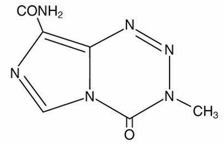
The material is a white to light tan/light pink powder with a molecular formula of C 6H 6N 6O 2 and a molecular weight of 194.15. The molecule is stable at acidic pH (<5) and labile at pH >7; hence temozolomide can be administered orally. The prodrug, temozolomide, is rapidly hydrolyzed to the active 5-(3-methyltriazen-1-yl) imidazole-4-carboxamide (MTIC) at neutral and alkaline pH values, with hydrolysis taking place even faster at alkaline pH.
Temozolomide Capsules:
Each capsule for oral use contains either 5 mg, 20 mg, 100 mg, 140 mg, 180 mg, or 250 mg of temozolomide.
The inactive ingredients for temozolomide capsules are as follows:
Temozolomide capsules 5 mg: lactose anhydrous (168 mg), colloidal anhydrous silica (1 mg), sodium starch glycolate (16 mg), tartaric acid (7 mg), and stearic acid (3 mg).
Temozolomide capsules 20 mg: lactose anhydrous (14.6 mg), colloidal anhydrous silica (0.2 mg), sodium starch glycolate (3.2 mg), tartaric acid (1.4 mg), and stearic acid (0.6 mg).
Temozolomide capsules 100 mg: lactose anhydrous (73 mg), colloidal anhydrous silica (1 mg), sodium starch glycolate (16 mg), tartaric acid (7 mg), and stearic acid (3 mg).
Temozolomide capsules 140 mg: lactose anhydrous (102.2 mg), colloidal anhydrous silica (1.4 mg), sodium starch glycolate (22.4 mg), tartaric acid (9.8 mg), and stearic acid (4.2 mg).
Temozolomide capsules 180 mg: lactose anhydrous (131.4 mg), colloidal anhydrous silica (1.8 mg), sodium starch glycolate (28.8 mg), tartaric acid (12.6 mg), and stearic acid (5.4 mg).
Temozolomide capsules 250 mg: lactose anhydrous (182.5 mg), colloidal anhydrous silica (2.5 mg), sodium starch glycolate (40 mg), tartaric acid (17.5 mg), and stearic acid (7.5 mg).
The body of the capsules is made of gelatin, and is white. The body of 250 mg capsule contain additionally sodium lauryl sulfate. The cap is also made of gelatin, and the colors vary based on the dosage strength. The capsule body and cap are imprinted with pharmaceutical branding ink, which contains black iron oxide, potassium hydroxide and shellac.
Temozolomide capsules 5 mg: The green cap contains gelatin, titanium dioxide, iron oxide yellow and FD&C Blue 2.
Temozolomide capsules 20 mg: The yellow cap contains gelatin, titanium dioxide and iron oxide yellow.
Temozolomide capsules 100 mg: The pink cap contains gelatin, titanium dioxide and iron oxide red.
Temozolomide capsules 140 mg: The transparent blue cap contains gelatin and FD&C Blue 2.
Temozolomide capsules 180 mg: The maroon cap contains gelatin, iron oxide red, iron oxide yellow and titanium dioxide.
Temozolomide capsules 250 mg: The white cap contains gelatin, titanium dioxide and sodium lauryl sulfate.
-
12 CLINICAL PHARMACOLOGY
12.1 Mechanism of Action
Temozolomide is not directly active but undergoes rapid nonenzymatic conversion at physiologic pH to the reactive compound 5-(3-methyltriazen-1-yl)-imidazole-4-carboxamide (MTIC). The cytotoxicity of MTIC is thought to be primarily due to alkylation of DNA. Alkylation (methylation) occurs mainly at the O 6 and N 7 positions of guanine.
12.3 Pharmacokinetics
Absorption:
Temozolomide is rapidly and completely absorbed after oral administration with a peak plasma concentration (C max) achieved in a median T max of 1 hour. Food reduces the rate and extent of temozolomide absorption. Mean peak plasma concentration and AUC decreased by 32% and 9%, respectively, and median T max increased by 2-fold (from 1 to 2.25 hours) when temozolomide was administered after a modified high-fat breakfast.
A pharmacokinetic study comparing oral and intravenous temozolomide in 19 patients with primary CNS malignancies showed that 150 mg/m 2 temozolomide for injection administered over 90 minutes is bioequivalent to 150 mg/m 2 temozolomide oral capsules with respect to both C max and AUC of temozolomide and MTIC. Following a single 90-minute intravenous infusion of 150 mg/m 2, the geometric mean C max values for temozolomide and MTIC were 7.3 mcg/mL and 276 ng/mL, respectively. Following a single oral dose of 150 mg/m 2, the geometric mean C max values for temozolomide and MTIC were 7.5 mcg/mL and 282 ng/mL, respectively. Following a single 90-minute intravenous infusion of 150 mg/m 2, the geometric mean AUC values for temozolomide and MTIC were 24.6 mcg∙hr/mL and 891 ng∙hr/mL, respectively. Following a single oral dose of 150 mg/m 2, the geometric mean AUC values for temozolomide and MTIC were 23.4 mcg∙hr/mL and 864 ng∙hr/mL, respectively.
Distribution:
Temozolomide has a mean apparent volume of distribution of 0.4 L/kg (%CV=13%). It is weakly bound to human plasma proteins; the mean percent bound of drug-related total radioactivity is 15%.
Metabolism and Elimination:
Temozolomide is spontaneously hydrolyzed at physiologic pH to the active species, MTIC and to temozolomide acid metabolite. MTIC is further hydrolyzed to 5-amino-imidazole-4-carboxamide (AIC), which is known to be an intermediate in purine and nucleic acid biosynthesis, and to methylhydrazine, which is believed to be the active alkylating species. Cytochrome P450 enzymes play only a minor role in the metabolism of temozolomide and MTIC. Relative to the AUC of temozolomide, the exposure to MTIC and AIC is 2.4% and 23%, respectively.
Excretion:
About 38% of the administered temozolomide total radioactive dose is recovered over 7 days: 37.7% in urine and 0.8% in feces. The majority of the recovery of radioactivity in urine is unchanged temozolomide (5.6%), AIC (12%), temozolomide acid metabolite (2.3%), and unidentified polar metabolite(s) (17%). Overall clearance of temozolomide is about 5.5 L/hr/m 2. Temozolomide is rapidly eliminated, with a mean elimination half-life of 1.8 hours, and exhibits linear kinetics over the therapeutic dosing range of 75 to 250 mg/m 2/day.
Effect of Age:
A population pharmacokinetic analysis indicated that age (range: 19 to 78 years) has no influence on the pharmacokinetics of temozolomide.
Effect of Gender:
A population pharmacokinetic analysis indicated that women have an approximately 5% lower clearance (adjusted for body surface area) for temozolomide than men.
Tobacco Use:
A population pharmacokinetic analysis indicated that the oral clearance of temozolomide is similar in smokers and nonsmokers.
Effect of Renal Impairment:
A population pharmacokinetic analysis indicated that creatinine clearance over the range of 36 to 130 mL/min/m 2 has no effect on the clearance of temozolomide after oral administration. The pharmacokinetics of temozolomide have not been studied in patients with severely impaired renal function (CLcr <36 mL/min/m 2). Caution should be exercised when temozolomide is administered to patients with severe renal impairment [see Use in Special Populations (8.6)] . Temozolomide has not been studied in patients on dialysis.
Effect of Hepatic Impairment:
A study showed that the pharmacokinetics of temozolomide in patients with mild-to-moderate hepatic impairment (Child-Pugh Class I – II) were similar to those observed in patients with normal hepatic function. Caution should be exercised when temozolomide is administered to patients with severe hepatic impairment [see Use in Specific Populations (8.7)] .
Effect of Other Drugs on Temozolomide Pharmacokinetics:
In a multiple-dose study, administration of temozolomide capsules with ranitidine did not change the C max or AUC values for temozolomide or MTIC.
A population analysis indicated that administration of valproic acid decreases the clearance of temozolomide by about 5% [see Drug Interactions (7.1)].
A population analysis did not demonstrate any influence of coadministered dexamethasone, prochlorperazine, phenytoin, carbamazepine, ondansetron, H 2-receptor antagonists, or phenobarbital on the clearance of orally administered temozolomide.
-
13 NONCLINICAL TOXICOLOGY
13.1 Carcinogenesis, Mutagenesis, Impairment of Fertility
Temozolomide is carcinogenic in rats at doses less than the maximum recommended human dose. Temozolomide induced mammary carcinomas in both males and females at doses 0.13 to 0.63 times the maximum human dose (25 to 125 mg/m 2) when administered orally on 5 consecutive days every 28 days for 6 cycles. Temozolomide also induced fibrosarcomas of the heart, eye, seminal vesicles, salivary glands, abdominal cavity, uterus, and prostate, carcinomas of the seminal vesicles, schwannomas of the heart, optic nerve, and harderian gland, and adenomas of the skin, lung, pituitary, and thyroid at doses 0.5 times the maximum daily dose. Mammary tumors were also induced following 3 cycles of temozolomide at the maximum recommended daily dose.
Temozolomide is a mutagen and a clastogen. In a reverse bacterial mutagenesis assay (Ames assay), temozolomide increased revertant frequency in the absence and presence of metabolic activation. Temozolomide was clastogenic in human lymphocytes in the presence and absence of metabolic activation.
Temozolomide impairs male fertility. Temozolomide caused syncytial cells/immature sperm formation at 0.25 and 0.63 times the maximum recommended human dose (50 and 125 mg/m 2) in rats and dogs, respectively, and testicular atrophy in dogs at 0.63 times the maximum recommended human dose (125 mg/m 2).
13.2 Animal Toxicology and/or Pharmacology
Toxicology studies in rats and dogs identified a low incidence of hemorrhage, degeneration, and necrosis of the retina at temozolomide doses equal to or greater than 0.63 times the maximum recommended human dose (125 mg/m 2). These changes were most commonly seen at doses where mortality was observed.
-
14 CLINICAL STUDIES
14.1 Newly Diagnosed Glioblastoma Multiforme
Five hundred and seventy-three patients were randomized to receive either temozolomide (TMZ)+Radiotherapy (RT) (n=287) or RT alone (n=286). Patients in the temozolomide+RT arm received concomitant temozolomide (75 mg/m 2 ) once daily, starting the first day of RT until the last day of RT, for 42 days (with a maximum of 49 days). This was followed by 6 cycles of temozolomide alone (150 or 200 mg/m 2) on Days 1 to 5 of every 28-day cycle, starting 4 weeks after the end of RT. Patients in the control arm received RT only. In both arms, focal radiation therapy was delivered as 60 Gy/30 fractions. Focal RT includes the tumor bed or resection site with a 2 to 3-cm margin. Pneumocystis pneumonia (PCP) prophylaxis was required during the TMZ + RT, regardless of lymphocyte count, and was to continue until recovery of lymphocyte count to less than or equal to Grade 1.
At the time of disease progression, temozolomide was administered as salvage therapy in 161 patients of the 282 (57%) in the RT alone arm, and 62 patients of the 277 (22%) in the temozolomide+RT arm.
The addition of concomitant and maintenance temozolomide to radiotherapy in the treatment of patients with newly diagnosed GBM showed a statistically significant improvement in overall survival compared to radiotherapy alone ( Figure 1). The hazard ratio (HR) for overall survival was 0.63 (95% CI for HR=0.52 to 0.75) with a log-rank P<0.0001 in favor of the temozolomide arm. The median survival was increased by 2.5 months in the temozolomide arm.
FIGURE 1: Kaplan-Meier Curves for Overall Survival (ITT Population)
14.2 Refractory Anaplastic Astrocytoma
A single-arm, multicenter study was conducted in 162 patients who had anaplastic astrocytoma at first relapse and who had a baseline Karnofsky performance status of 70 or greater. Patients had previously received radiation therapy and may also have previously received a nitrosourea with or without other chemotherapy. Fifty-four patients had disease progression on prior therapy with both a nitrosourea and procarbazine, and their malignancy was considered refractory to chemotherapy (refractory anaplastic astrocytoma population). Median age of this subgroup of 54 patients was 42 years (19 to 76). Sixty-five percent were male. Seventy-two percent of patients had a KPS of >80. Sixty-three percent of patients had surgery other than a biopsy at the time of initial diagnosis. Of those patients undergoing resection, 73% underwent a subtotal resection and 27% underwent a gross total resection. Eighteen percent of patients had surgery at the time of first relapse. The median time from initial diagnosis to first relapse was 13.8 months (4.2 to 75.4).
Temozolomide capsules were given for the first 5 consecutive days of a 28-day cycle at a starting dose of 150 mg/m 2/day. If the nadir and day of dosing (Day 29, Day 1 of next cycle) absolute neutrophil count was greater than or equal to 1.5 x 10 9/L (1500/μL) and the nadir and Day 29, Day 1 of next cycle platelet count was greater than or equal to 100 x 10 9/L (100,000/μL), the temozolomide dose was increased to 200 mg/m 2/day for the first 5 consecutive days of a 28-day cycle.
In the refractory anaplastic astrocytoma population, the overall tumor response rate (CR + PR) was 22% (12/54 patients) and the complete response rate was 9% (5/54 patients). The median duration of all responses was 50 weeks (range: 16 to 114 weeks) and the median duration of complete responses was 64 weeks (range: 52 to 114 weeks). In this population, progression-free survival at 6 months was 45% (95% CI: 31% to 58%) and progression-free survival at 12 months was 29% (95% CI: 16% to 42%). Median progression-free survival was 4.4 months. Overall survival at 6 months was 74% (95% CI: 62% to 86%) and 12-month overall survival was 65% (95% CI: 52% to 78%). Median overall survival was 15.9 months.
-
15 REFERENCES
- OSHA Technical Manual, TED 1-0.15A, Section VI: Chapter 2. Controlling Occupational Exposure to Hazardous Drugs. OSHA, 1999.
- American Society of Health-System Pharmacists. ASHP guidelines on handling hazardous drugs. Am J Health-Syst Pharm. 2006; 63:1172-1193.
- NIOSH Alert: Preventing occupational exposures to antineoplastic and other hazardous drugs in healthcare settings. 2004. U.S. Department of Health and Human Services, Public Health Service, Centers for Disease Control and Prevention, National Institute for Occupational Safety and Health, DHHS (NIOSH) Publication No. 2004-165.[3]
- Polovich, M., White, J. M., & Kelleher, L.O. (eds.) 2005. Chemotherapy and biotherapy guidelines and recommendations for practice (2nd. ed.) Pittsburgh, PA: Oncology.
-
16 HOW SUPPLIED/STORAGE AND HANDLING
16.1 Safe Handling and Disposal
Care should be exercised in the handling and preparation of temozolomide capsules. Vials and capsules should not be opened. If vials or capsules are accidentally opened or damaged, rigorous precautions should be taken with the contents to avoid inhalation or contact with the skin or mucous membranes. The use of gloves and safety glasses is recommended to avoid exposure in case of breakage of the vial or capsules. Procedures for proper handling and disposal of anticancer drugs should be considered {1–4}. Several guidelines on this subject have been published.
16.2 How Supplied
Temozolomide Capsules:
Temozolomide Capsules are supplied in amber glass bottles with child-resistant polypropylene caps and sachet packs containing the following capsule strengths:
Temozolomide Capsules 5 mg: have white bodies with green caps. The capsule body is imprinted with '5'. The cap is imprinted with 'TMZ'.
They are supplied as follows:
Amber Glass Bottles
5 count – NDC: 16729-048-53
14 count – NDC: 16729-048-54
Sachet Packs (Carton Contains Individual Sachet with One Capsule each):
5 count – NDC: 16729-048-31
14 count – NDC: 16729-048-04
Temozolomide Capsules 20 mg: have white bodies with yellow caps. The capsule body is imprinted with '20'. The cap is imprinted with 'TMZ'.
They are supplied as follows:
Amber Glass Bottles
5 count – NDC: 16729-049-53
14 count – NDC: 16729-049-54
Sachet Packs (Carton Contains Individual Sachet with One Capsule each):
5 count – NDC: 16729-049-31
14 count – NDC: 16729-049-04
Temozolomide Capsules 100 mg: have white bodies with pink caps. The capsule body is imprinted with '100'. The cap is imprinted with 'TMZ'.
They are supplied as follows:
Amber Glass Bottles
5 count – NDC: 16729-050-53
14 count – NDC: 16729-050-54
Sachet Packs (Carton Contains Individual Sachet with One Capsule each):
5 count – NDC: 16729-050-31
14 count – NDC: 16729-050-04
Temozolomide Capsules 140 mg: have white bodies with transparent blue caps. The capsule body is imprinted with '140'. The cap is imprinted with 'TMZ'.
They are supplied as follows:
Amber Glass Bottles
5 count – NDC: 16729-129-53
14 count – NDC: 16729-129-54
Sachet Packs (Carton Contains Individual Sachet with One Capsule each):
5 count – NDC: 16729-129-31
14 count – NDC: 16729-129-04
Temozolomide Capsules 180 mg: have white bodies with maroon caps. The capsule body is imprinted with '180'. The cap is imprinted with 'TMZ'.
They are supplied as follows:
Amber Glass Bottles
5 count – NDC: 16729-130-53
14 count – NDC: 16729-130-54
Sachet Packs (Carton Contains Individual Sachet with One Capsule each):
5 count – NDC: 16729-130-31
14 count – NDC: 16729-130-04
Temozolomide Capsules 250 mg: have white bodies with white caps. The capsule body is imprinted with '250'. The cap is imprinted with 'TMZ'.
They are supplied as follows:
Amber Glass Bottles
5 count – NDC: 16729-051-53
Sachet Packs (Carton Contains Individual Sachet with One Capsule each):
5 count – NDC: 16729-051-31
-
17 PATIENT COUNSELING INFORMATION
Advise the patient to read the FDA-approved patient labeling (Patient Information).
17.1 Information for the Patient
Physicians should discuss the following with their patients:
- Nausea and vomiting are the most frequently occurring adverse reactions. Nausea and vomiting are usually either self-limiting or readily controlled with standard antiemetic therapy.
- Capsules should not be opened. If capsules are accidentally opened or damaged, rigorous precautions should be taken with the capsule contents to avoid inhalation or contact with the skin or mucous membranes.
- The medication should be kept away from children and pets.
Manufactured For:
Accord Healthcare, Inc.,
1009 Slater Road,
Suite 210-B,
Durham, NC 27703,
USA.Manufactured By:
Intas Pharmaceuticals Limited,
Ahmedabad – 380 054, India.10 1475 1 687163
Issued July 2018
-
SPL UNCLASSIFIED SECTION
Pharmacist: Tear at perforations and give to patients
Patient Information
Temozolomide Capsules
(TEM-oh-ZOE-loe-mide)What is the most important information I should know about temozolomide capsules?
- Temozolomide capsules may cause birth defects. Male and female patients who take temozolomide capsules should use effective birth control. Female patients and female partners of male patients should avoid becoming pregnant while taking temozolomide capsules.
See the section “What are the possible side effects of temozolomide capsules?” for more information about side effects.
What is temozolomide capsule?
Temozolomide capsule is a prescription medicine used to treat adults with certain brain cancer tumors. Temozolomide capsules blocks cell growth, especially cells that grow fast, such as cancer cells. Temozolomide capsules may decrease the size of certain brain tumors in some patients.
It is not known if temozolomide capsule is safe and effective in children.Who should not take temozolomide capsules?
Do not take temozolomide capsule if you:
- have had an allergic reaction to dacarbazine (DTIC), another cancer medicine.
- have had a red itchy rash, or a severe allergic reaction, such as trouble breathing, swelling of the face, throat, or tongue, or severe skin reaction to temozolomide or any of the ingredients in temozolomide capsules. If you are not sure, ask your doctor. See the end of the leaflet for a list of ingredients in temozolomide capsules.
What should I tell my doctor before taking temozolomide capsules?
Tell your doctor about all your medical conditions, including if you:
- are allergic to dacarbazine (DTIC) or have had a severe allergic reaction to temozolomide capsules. See “Who should not take temozolomide capsules?”
- have kidney problems
- have liver problems
- are pregnant. See “What is the most important information I should know about temozolomide capsules?”
- are breast-feeding. It is not known whether temozolomide passes into breast milk. You and your doctor should decide if you will breast-feed or take temozolomide capsules. You should not do both without talking with your doctor.
Tell your doctor about all the medicines you take, including prescription and non-prescription medicines, vitamins, and herbal supplements. Especially tell your doctor if you take a medicine that contains valproic acid (Stavzor®, Depakene®).
Know the medicines you take. Keep a list of them and show it to your doctor and pharmacist when you get a new medicine.How should I take temozolomide capsules?
Temozolomide capsules may be taken by mouth as a capsule at home. Your doctor will decide the best way for you to take temozolomide capsules.
There are two common dosing schedules for taking temozolomide capsules.- Some people take temozolomide capsules for 42 days in a row (possibly 49 days depending on side effects) with radiation treatment. This is one cycle of treatment. After this, you may have “maintenance” treatment. Your doctor may prescribe 6 more cycles of temozolomide capsules. For each of these cycles, you take temozolomide capsules one time each day for 5 days in a row and then you stop taking it for the next 23 days. This is a 28-day maintenance treatment cycle.
- Another way to take temozolomide capsule is to take it one time each day for 5 days in a row only, and then you stop taking it for the next 23 days. This is one cycle of treatment (28 days). Your doctor will watch your progress on temozolomide capsules and decide how long you should take it. You might take temozolomide capsules until your tumor gets worse or for possibly up to 2 years.
- Your dose is based on your height and weight, and the number of treatment cycles will depend on how you respond to and tolerate this treatment.
- Your doctor may modify your schedule based on how you tolerate the treatment.
- If your doctor prescribes a treatment regimen that is different from the information in this leaflet, make sure you follow the specific instructions given to you by your doctor.
Temozolomide Capsules:
- Take temozolomide capsules exactly as prescribed.
- Temozolomide capsules come in different strengths. Each strength has a different color cap. Your doctor may prescribe more than one strength of temozolomide capsules for you, so it is important that you understand how to take your medicine the right way. Be sure that you understand exactly how many capsules you need to take on each day of your treatment, and what strengths to take. This may be different whenever you start a new cycle.
- Talk to your doctor before you take your dose if you are not sure how much to take. This will help to prevent taking too much temozolomide capsules and decrease your chances of getting serious side effects.
- Take each day’s dose of temozolomide capsules at one time, with a full glass of water.
- Swallow temozolomide capsules whole. Do not chew, open, or split the capsules.
- If temozolomide capsules are accidentally opened or damaged, be careful not to breathe in (inhale) the powder from the capsules or get the powder on your skin or mucous membranes (for example, in your nose or mouth). If contact with any of these areas happens, flush the area with water.
- If you vomit temozolomide capsules, do not take any more capsules. Wait and take your next planned dose.
- The medicine is used best by your body if you take it at the same time every day in relation to a meal.
- To lessen nausea, try to take temozolomide capsules on an empty stomach or at bedtime. Your doctor may prescribe medicine to prevent or treat nausea, or other medicines to lessen side effects with temozolomide capsules.
- See your doctor regularly to check your progress. Your doctor will check you for side effects that you might not notice.
- If you miss a dose of temozolomide capsules, talk with your doctor for instructions about when to take your next dose of temozolomide capsules.
- Call your doctor right away if you take more than the prescribed amount of temozolomide capsules. It is important that you do not take more than the amount of temozolomide capsules prescribed for you.
What should I avoid while taking temozolomide capsules?
- Female patients and female partners of male patients should avoid becoming pregnant while taking temozolomide capsules. See “What is the most important information I should know about temozolomide capsules?”
What are the possible side effects of temozolomide capsules?
Temozolomide capsules can cause serious side effects.- See “What is the most important information I should know about temozolomide capsules?”
-
Decreased blood cells. Temozolomide capsules affects cells that grow rapidly, including bone marrow cells. This can cause you to have a decrease in blood cells. Your doctor can monitor your blood for these effects.
- White blood cells are needed to fight infections. Neutrophils are a type of white blood cell that help prevent bacterial infections. Decreased neutrophils can lead to serious infections that can lead to death. Other white blood cells called lymphocytes may also be decreased.
- Platelets are blood cells needed for normal blood clotting. Low platelet counts can lead to bleeding. Tell your doctor about any unusual bruising or bleeding.
Your doctor will check your blood regularly while you are taking temozolomide capsules to see if these side effects are happening. Your doctor may need to change the dose of temozolomide capsules or when you get it depending on your blood cell counts. People who are age 70 or older and women may be more likely to have their blood cells affected.
- Pneumocystis pneumonia (PCP). PCP is an infection that people can get when their immune system is weak. Temozolomide capsules decreases white blood cells, which makes your immune system weaker and can increase your risk of getting PCP. All patients taking temozolomide capsules will be watched carefully by their doctor for this infection, especially patients who take steroids. Tell your doctor if you have any of the following signs and symptoms of PCP infection: shortness of breath and/or fever, chills, dry cough.
- Secondary cancers. Blood problems such as myelodysplastic syndrome and secondary cancers, such as a certain kind of leukemia, can happen in people who take temozolomide capsules. Your doctor will watch you for this.
- Convulsions. Convulsions may be severe or life-threatening in people who take temozolomide capsules.
- Liver side effects have been reported, which very rarely included death.
Common side effects with temozolomide capsules include:
- nausea and vomiting. Your doctor can prescribe medicines that may help reduce these symptoms.
- headache
- feeling tired
- loss of appetite
- hair loss
- constipation
- bruising
- rash
- paralysis on one side of the body
- diarrhea
- weakness
- fever
- dizziness
- coordination problems
- viral infection
- sleep problems
- memory loss
- pain, irritation, itching, warmth, swelling or redness at the site of infusion
- bruising or small red or purple spots under the skin
Tell your doctor about any side effect that bothers you or that does not go away.
These are not all the possible side effects with temozolomide capsules. For more information, ask your doctor or pharmacist.
Call your doctor for medical advice about side effects. You may report side effects to FDA at 1-800-FDA-1088.
How should I store temozolomide capsules?
- Store temozolomide capsules at 77°F (controlled room temperature). Storage at 59°F to 86°F (15°C to 30°C) is permitted occasionally.
- Keep temozolomide capsules out of the reach of children and pets.
General information about temozolomide capsules.
Medicines are sometimes prescribed for purposes other than those listed in the Patient Information leaflet. Do not use temozolomide capsules for a condition for which it was not prescribed. Do not give temozolomide capsules to other people, even if they have the same symptoms that you have. It may harm them.
This leaflet summarizes the most important information about temozolomide capsules. If you would like more information, talk with your doctor. You can ask your pharmacist or doctor for information about temozolomide capsules that is written for health professionals.For more information, go to www.accordhealthcare.us or call Accord Healthcare at 1-866-941-7875.
How are temozolomide capsules supplied?
Temozolomide capsules contain a white capsule body with a color cap and the colors vary based on the dosage strength. The capsules are available in six different strengths.Temozolomide Capsule Strength Color 5 mg Green Cap 20 mg Yellow Cap 100 mg Pink Cap 140 mg Transparent Blue Cap 180 mg Maroon Cap 250 mg White Cap What are the ingredients in temozolomide capsules?
Temozolomide capsules:
Active ingredient: temozolomide.
Inactive ingredients: lactose anhydrous, colloidal anhydrous silica, sodium starch glycolate, tartaric acid, stearic acid.
The body of the capsules is made of gelatin, and is white. The body of 250 mg capsule contain additionally sodium lauryl sulfate. The cap is also made of gelatin, and the colors vary based on the dosage strength. The capsule body and cap are imprinted with pharmaceutical branding ink, which contains black iron oxide, potassium hydroxide and shellac.Temozolomide capsules 5 mg: The green cap contains gelatin, titanium dioxide, iron oxide yellow and FD&C Blue 2.
Temozolomide capsules 20 mg: The yellow cap contains gelatin, iron oxide yellow and titanium dioxide.
Temozolomide capsules 100 mg: The pink cap contains gelatin, titanium dioxide and iron oxide red.
Temozolomide capsules 140 mg: The transparent blue cap contains gelatin and FD&C Blue 2.
Temozolomide capsules 180 mg: The maroon cap contains gelatin, iron oxide red, iron oxide yellow and titanium dioxide.
Temozolomide capsules 250 mg: The white cap contains gelatin, titanium dioxide and sodium lauryl sulfate.
®The brands listed are trademarks of their respective owners.
Manufactured For:
Accord Healthcare, Inc.,
1009 Slater Road,
Suite 210-B,
Durham, NC 27703,
USA.
Manufactured By:
Intas Pharmaceuticals Limited,
Ahmedabad – 380 054, India.
10 1475 1 687163
Issued July 2018
Temozolomide Capsules
PHARMACIST:
Dispense enclosed Patient Package Insert to each patient.PHARMACIST INFORMATION SHEET
IMPORTANT DISPENSING INFORMATION
For every patient, temozolomide capsules must be dispensed in a separate vial or in its original package making sure each container lists the strength per capsule and that patients take the appropriate number of capsules from each package or vial.
Please see the dispensing instructions below for more information.
What is temozolomide capsule?
Temozolomide is an oral alkylating agent for the treatment of newly diagnosed glioblastoma multiforme and refractory anaplastic astrocytoma.
How is temozolomide capsules dosed?
The daily dose of temozolomide capsules for a given patient is calculated by the physician, based on the patient’s body surface area (BSA). The resulting dose is then rounded off to the nearest 5 mg. An example of the dosing may be as follows: the initial daily dose of temozolomide capsules in milligrams is the BSA multiplied by mg/m 2/day, (a patient with a BSA of 1.84 is 1.84 x 75 mg = 138, or 140 mg/day). The dose for subsequent cycles may be adjusted according to nadir neutrophil and platelet counts in the previous cycle and at the time of initiating the next cycle.
How might the dose of temozolomide capsules be modified for Refractory Anaplastic Astrocytoma?
Dosage of temozolomide capsules must be adjusted according to nadir neutrophil and platelet counts in the previous cycle and neutrophil and platelet counts at the time of initiating the next cycle. The initial dose is 150 mg/m 2 orally once daily for 5 consecutive days per 28-day treatment cycle. If both the nadir and day of dosing (Day 29, Day 1 of next cycle) absolute neutrophil counts (ANC) are greater than or equal to 1.5 x 10 9/L (1500/μL) and both the nadir and Day 29, Day 1 of next cycle platelet counts are greater than or equal to 100 x 10 9/L (100,000/μL), the temozolomide capsules dose may be increased to 200 mg/m 2/day for 5 consecutive days per 28-day treatment cycle. During treatment, a complete blood count should be obtained on Day 22 (21 days after the first dose) or within 48 hours of that day, and weekly until the ANC is above 1.5 x 10 9/L (1500/μL) and the platelet count exceeds 100 x 10 9/L (100,000/μL). The next cycle of temozolomide capsules should not be started until the ANC and platelet count exceed these levels. If the ANC falls to less than 1.0 x 10 9/L (1000/μL) or the platelet count is less than 50 x 10 9/L (50,000/μL) during any cycle, the next cycle should be reduced by 50 mg/m 2, but not below 100 mg/m 2, the lowest recommended dose (see Table 1 below)

What is the temozolomide capsules treatment regimen?
Temozolomide capsules are given for 5 consecutive days on a 28-day cycle. Patients should continue taking temozolomide capsules until their physician determines that their disease has progressed, up to 2 years, or until unacceptable side effects or toxicities occur. Physicians may alter the treatment regimen for a given patient.
Newly Diagnosed Concomitant Phase Treatment Schedule
Temozolomide capsules are administered orally at 75 mg/m 2 daily for 42 days concomitant with focal radiotherapy (60 Gy administered in 30 fractions), followed by maintenance temozolomide capsules for 6 cycles. No dose reductions are recommended; however, dose interruptions may occur based on patient tolerance. The temozolomide capsules dose can be continued throughout the 42 day concomitant period up to 49 days if all of the following conditions are met: absolute neutrophil count greater than or equal to 1.5 x 10 9/L, platelet count greater than or equal to 100 x10 9/L, common toxicity criteria (CTC) nonhematological toxicity less than or equal to Grade 1 (except for alopecia, nausea and vomiting). During treatment a complete blood count should be obtained weekly. Temozolomide dosing should be interrupted or discontinued during concomitant phase according to the hematological and nonhematological toxicity criteria as noted in Table 2. Pneumocystis pneumonia (PCP) prophylaxis is required during the concomitant administration of temozolomide and radiotherapy, and should be continued in patients who develop lymphocytopenia until recovery from lymphocytopenia (CTC grade less than or equal to 1).
TABLE 2: Temozolomide Dosing Interruption or Discontinuation During Concomitant Radiotherapy and Temozolomide TMZ = temozolomide; CTC = Common Toxicity Criteria. - * Treatment with concomitant TMZ could be continued when all of the following conditions were met: absolute neutrophil count greater than or equal to 1.5 x 10 9/L; platelet count greater than or equal to 100 x 10 9/L; CTC nonhematological toxicity less than or equal to Grade 1 (except for alopecia, nausea, vomiting).
Toxicity TMZ Interruption * TMZ Discontinuation Absolute Neutrophil Count greater than or equal to
0.5 and less than 1.5 x 10 9/Lless than 0.5 x 10 9/L Platelet Count greater than or equal to 10 and less than 100 x 10 9/L less than 10 x 10 9/L CTC Nonhematological Toxicity (except for alopecia, nausea, vomiting)
CTC Grade 2
CTC Grade 3 or 4Maintenance Phase Treatment Schedule
Four weeks after completing the temozolomide + RT phase, temozolomide capsules are administered for an additional 6 cycles of maintenance treatment. Dosage in Cycle 1 (maintenance) is 150 mg/m 2 once daily for 5 days followed by 23 days without treatment. At the start of Cycle 2, the dose is escalated to 200 mg/m 2, if the CTC nonhematologic toxicity for Cycle 1 is Grade less than or equal to 2 (except for alopecia, nausea and vomiting), absolute neutrophil count (ANC) is greater than or equal to 1.5 x 10 9/L, and the platelet count is greater than or equal to 100 x 10 9/L. If the dose was not escalated at Cycle 2, escalation should not be done in subsequent cycles. The dose remains at 200 mg/m 2 per day for the first 5 days of each subsequent cycle except if toxicity occurs.
During treatment a complete blood count should be obtained on Day 22 (21 days after the first dose) or within 48 hours of that day, and weekly until the ANC is above 1.5 x 10 9/L (1500/μL) and the platelet count exceeds 100 x 10 9/L (100,000/μL). The next cycle of temozolomide capsules should not be started until the ANC and platelet count exceed these levels. Dose reductions during the next cycle should be based on the lowest blood counts and worst nonhematologic toxicity during the previous cycle. Dose reductions or discontinuations during the maintenance phase should be applied according to Tables 3 and 4.
TABLE 3: Temozolomide Dose Levels for Maintenance Treatment Dose Level Dose (mg/m 2/day) Remarks -1 100 Reduction for prior toxicity 0 150 Dose during Cycle 1 1 200 Dose during Cycles 2-6 in absence of toxicity TABLE 4: Temozolomide Dose Reduction or Discontinuation During Maintenance Treatment TMZ = temozolomide; CTC = Common Toxicity Criteria. - * TMZ dose levels are listed in Table 3.
- † TMZ is to be discontinued if dose reduction to less than 100 mg/m 2 is required or if the same Grade 3 nonhematological toxicity (except for alopecia, nausea, vomiting) recurs after dose reduction.
Toxicity Reduce TMZ by 1 Dose Level * Discontinue TMZ Absolute Neutrophil Count less than 1.0 x 10 9/L See footnote † Platelet Count less than 50 x 10 9/L See footnote † CTC Nonhematological Toxicity
(except for alopecia, nausea, vomiting)
CTC Grade 3
CTC Grade 4 †How is temozolomide capsules taken?
Patients should take each day’s dose with a full glass of water at the same time each day. Taking the medication on an empty stomach or at bedtime may help ease nausea. If patients are also taking antinausea or other medications to relieve the side effects associated with temozolomide, they should be advised to take these medications 30 minutes before they take temozolomide capsules. Temozolomide causes the rapid appearance of malignant tumors in rats. Patients SHOULD NOT open or split the capsules. If capsules are accidentally opened or damaged, rigorous precautions should be taken with the capsule contents to avoid inhalation or contact with the skin or mucous membranes. The medication should be kept away from children and pets. The temozolomide capsules should be swallowed whole and NEVER CHEWED.
What should the patient avoid during treatment with temozolomide capsules?
There are no dietary restrictions for patients taking temozolomide capsules. Temozolomide capsules may affect testicular function, so male patients should exercise adequate birth control measures. Temozolomide capsules may cause birth defects. Female patients should avoid becoming pregnant while receiving this drug. Women who are nursing prior to receiving temozolomide capsules should discontinue nursing. It is not known whether temozolomide is excreted into breast milk. Because many drugs are excreted in human milk, and because of the potential for serious adverse reactions in nursing infants and tumorigenicity shown for temozolomide in animal studies, a decision should be made whether to discontinue nursing or to discontinue the drug, taking into account the importance of temozolomide capsules to the mother.
What are the side effects of temozolomide capsules?
Nausea and vomiting are the most common side effects associated with temozolomide capsules. Noncumulative myelosuppression is the dose-limiting toxicity. Patients should be evaluated periodically by their physician to monitor blood counts.
Other commonly reported side effects reported by patients taking temozolomide capsules are fatigue, constipation, alopecia, anorexia, and headache.
How is temozolomide capsules supplied?
Temozolomide capsules are available in 5-mg, 20-mg, 100-mg, 140-mg, 180-mg, and 250-mg strengths. The capsules contain a white capsule body with a color cap, and the colors vary based on the dosage strength.
Temozolomide Capsule Strength Color 5 mg Green Cap 20 mg Yellow Cap 100 mg Pink Cap 140 mg Transparent Blue Cap 180 mg Maroon Cap 250 mg White Cap The 5-mg, 20-mg, 100-mg, 140-mg, and 180-mg capsule strengths are available in 5 count and 14 count packages. The 250-mg capsule strengths are available in 5 count package.
How is temozolomide capsules dispensed?
Each strength of temozolomide capsules must be dispensed in a separate vial or in its original package (one strength per one container). Follow the instructions below:
Based on the dose prescribed, determine the number of each strength of temozolomide capsules needed for the full 42-or 5-day cycle as prescribed by the physician. For example, in a 5-day cycle, 275 mg/day would be dispensed as five 250-mg capsules, five 20-mg capsules and five 5-mg capsules. Label each container with the appropriate number of capsules to be taken each day. Dispense to the patient, making sure each container lists the strength (mg) per capsule and that he or she understands to take the appropriate number of capsules of temozolomide from each package or vial to equal the total daily dose prescribed by the physician.
How can temozolomide capsules be ordered?
Temozolomide capsules can be ordered from your wholesaler. It is important to understand if temozolomide capsules are being used as part of a 42-day regimen or as part of a 5-day course. Remember to order enough temozolomide capsules for the appropriate cycle. For example:
- a 5-day course of 360 mg/day would require the following to be ordered: two 5-count packages of 180-mg capsules.
- a 42-day course of 140 mg/day would require the following to be ordered: three 14-count packages of 140-mg capsules.
For examples of other dosing regimens, please refer to the full Prescribing Information (Table 6).
Temozolomide Capsules NDC Number Amber Glass Bottles: 5-mg capsules (5 count) 16729-048-53 5-mg capsules (14 count) 16729-048-54 20-mg capsules (5 count) 16729-049-53 20-mg capsules (14 count) 16729-049-54 100-mg capsules (5 count) 16729-050-53 100-mg capsules (14 count) 16729-050-54 140-mg capsules (5 count) 16729-129-53 140-mg capsules (14 count) 16729-129-54 180-mg capsules (5 count) 16729-130-53 180-mg capsules (14 count) 16729-130-54 250-mg capsules (5 count) 16729-051-53 Sachet Packs (Carton Contains Individual Sachet with One Capsule each): 5-mg capsules (5 count) 16729-048-31 5-mg capsules (14 count) 16729-048-04 20-mg capsules (5 count) 16729-049-31 20-mg capsules (14 count) 16729-049-04 100-mg capsules (5 count) 16729-050-31 100-mg capsules (14 count) 16729-050-04 140-mg capsules (5 count) 16729-129-31 140-mg capsules (14 count) 16729-129-04 180-mg capsules (5 count) 16729-130-31 180-mg capsules (14 count) 16729-130-04 250-mg capsules (5 count) 16729-051-31 Manufactured For:
Accord Healthcare, Inc.,
1009 Slater Road,
Suite 210-B,
Durham, NC 27703,
USA.
Manufactured By:
Intas Pharmaceuticals Limited,
Ahmedabad – 380 054, India.
10 1475 1 687163
Issued July 2018
-
PRINCIPAL DISPLAY PANEL
PRINCIPAL DISPLAY PANEL
Principal Display Panel- 5 mg Capsules
Amber Glass Bottle Carton
NDC 16729- 048-53
Temozolamide
Capsules5 mg
Rx only
5 capsules
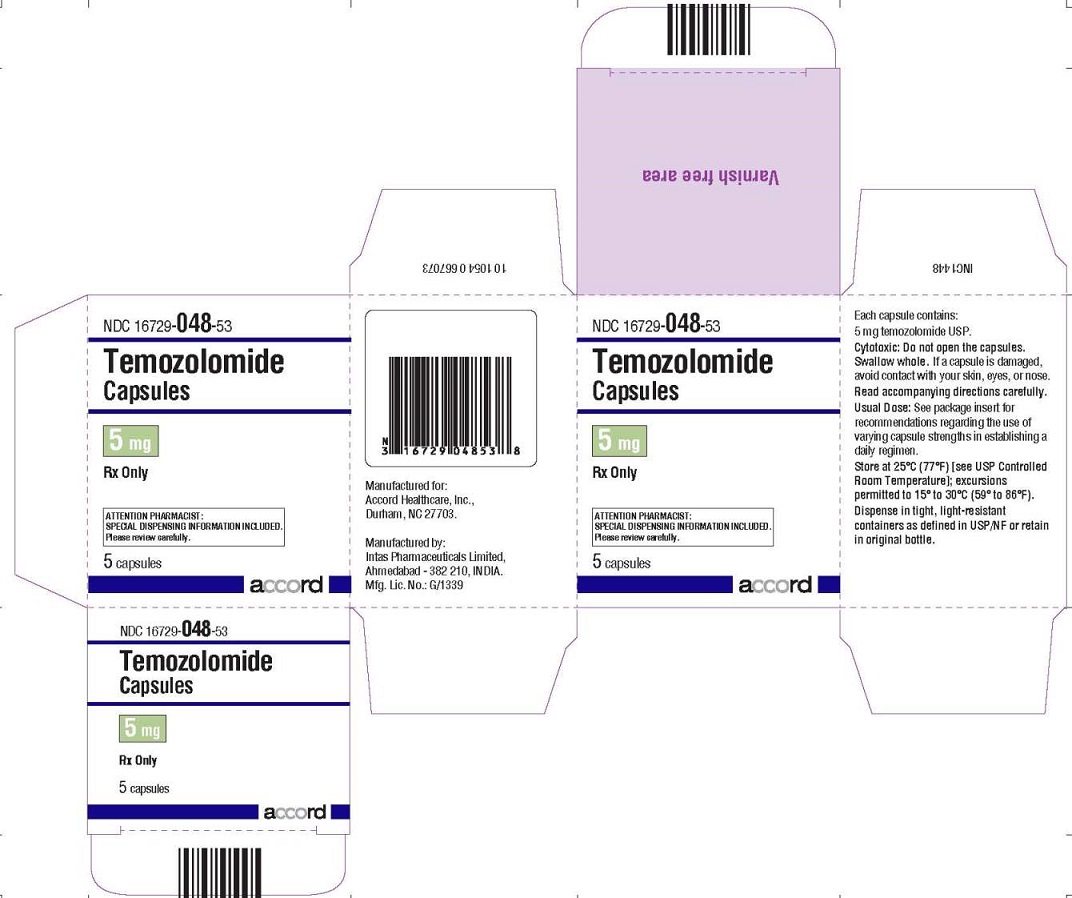
Principal Display Panel- 20 mg Capsules
Amber Glass Bottle Carton
NDC 16729- 049-53
Temozolamide
Capsules20 mg
Rx only
5 capsules
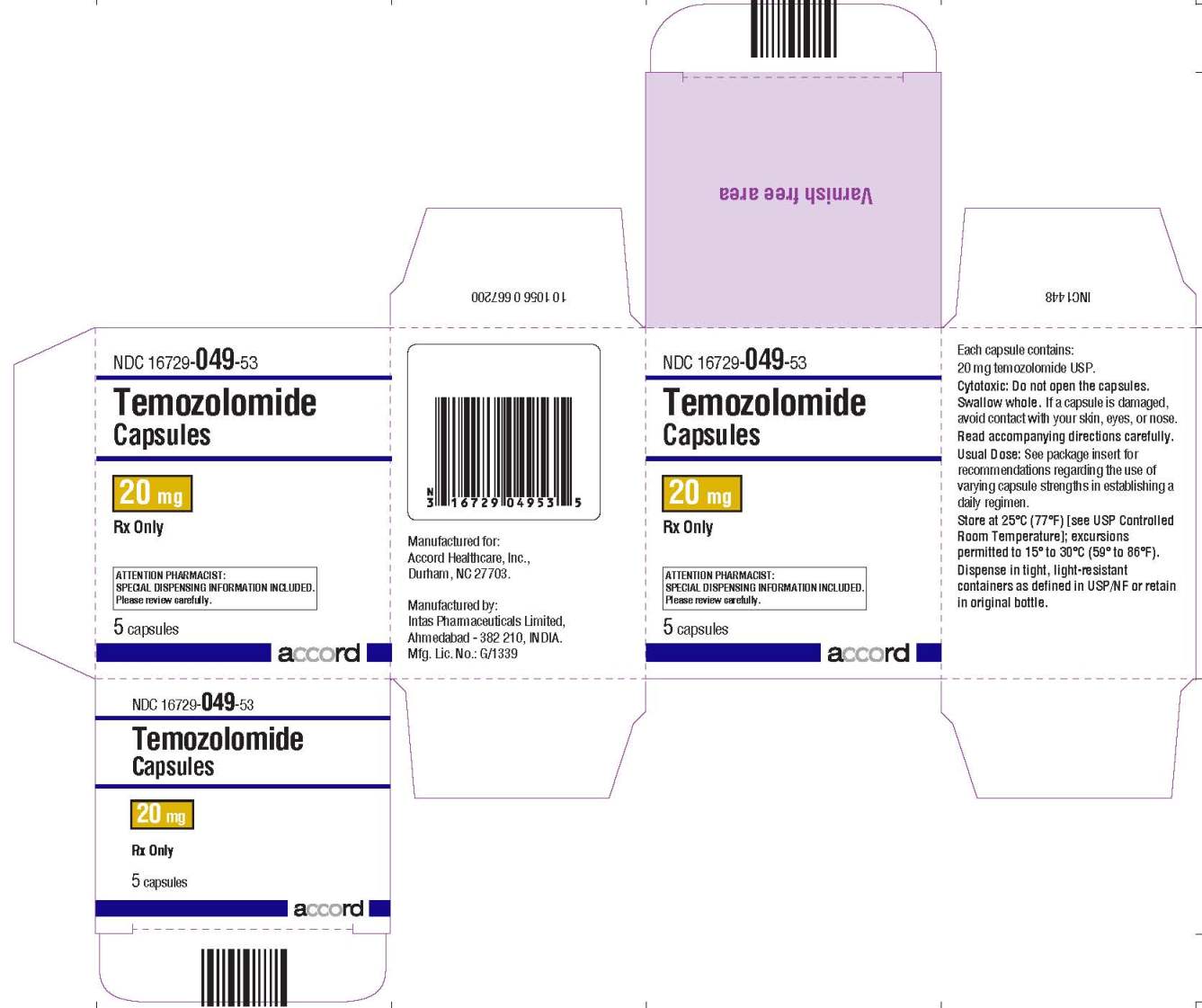
Principal Display Panel- 100 mg Capsules
Amber Glass Bottle Carton
NDC 16729- 050-53
Temozolamide
Capsules100 mg
Rx only
5 capsules
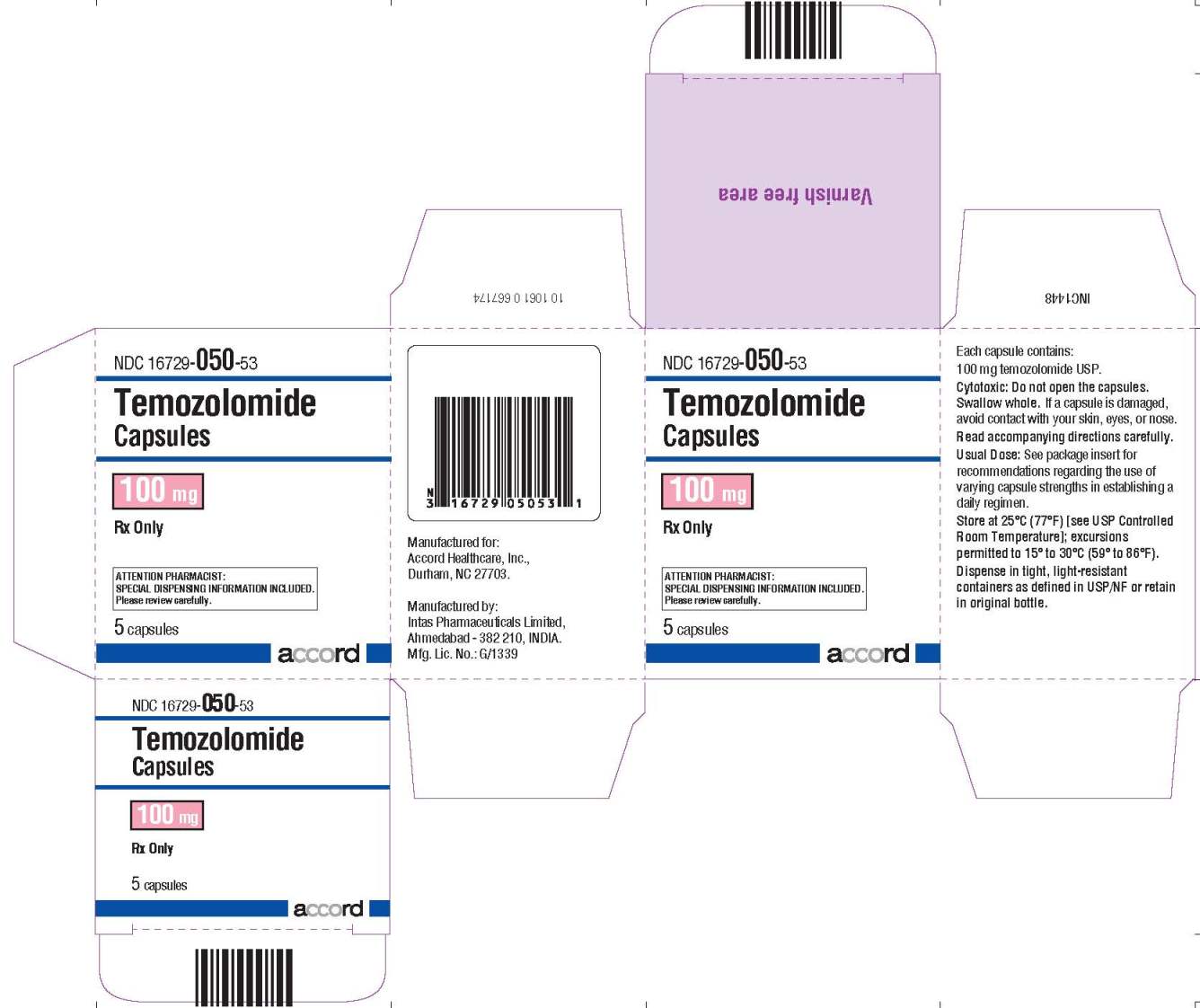
Principal Display Panel- 140 mg Capsules
Amber Glass Bottle Carton
NDC 16729- 129-53
Temozolamide
Capsules140 mg
Rx only
5 capsules
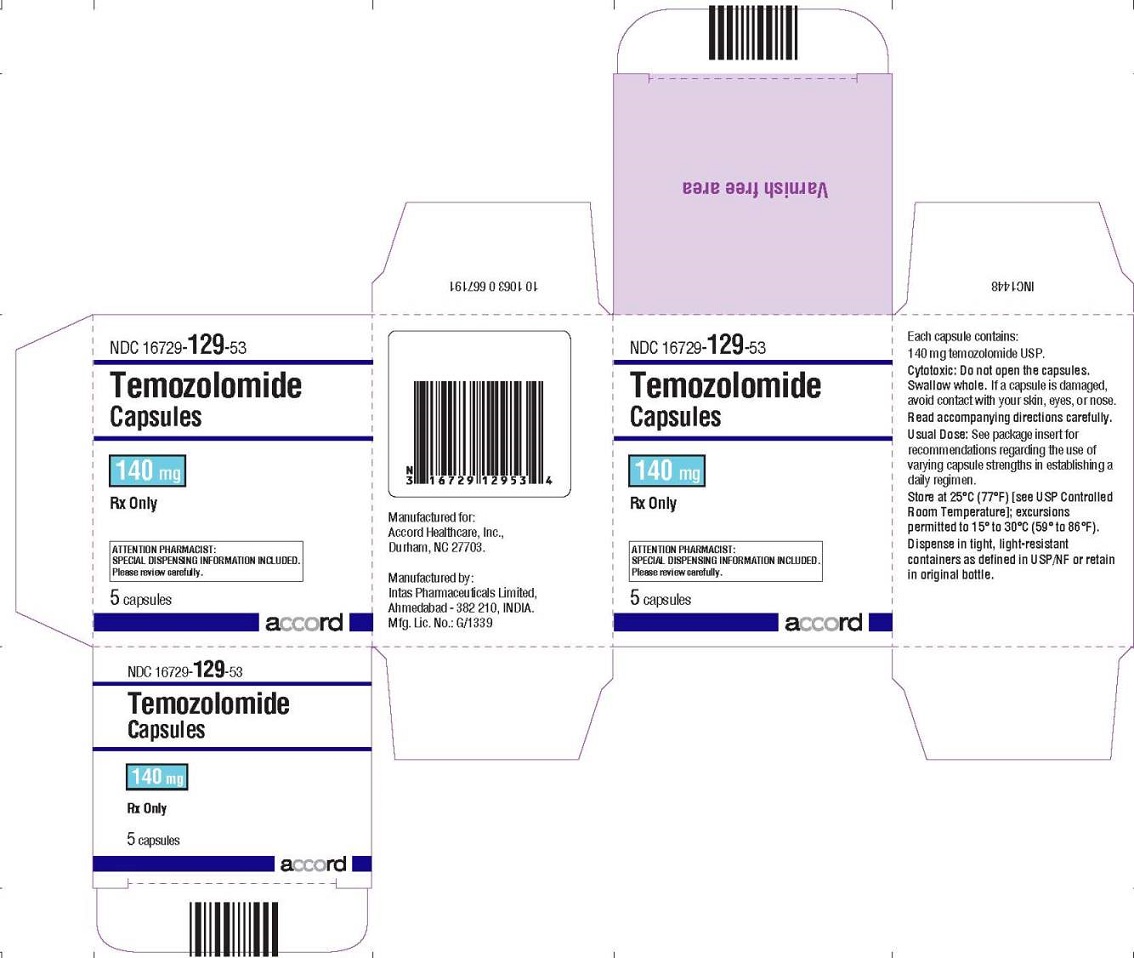
Principal Display Panel- 180 mg Capsules
Amber Glass Bottle Carton
NDC 16729- 130-53
Temozolamide
Capsules180 mg
Rx only
5 capsules
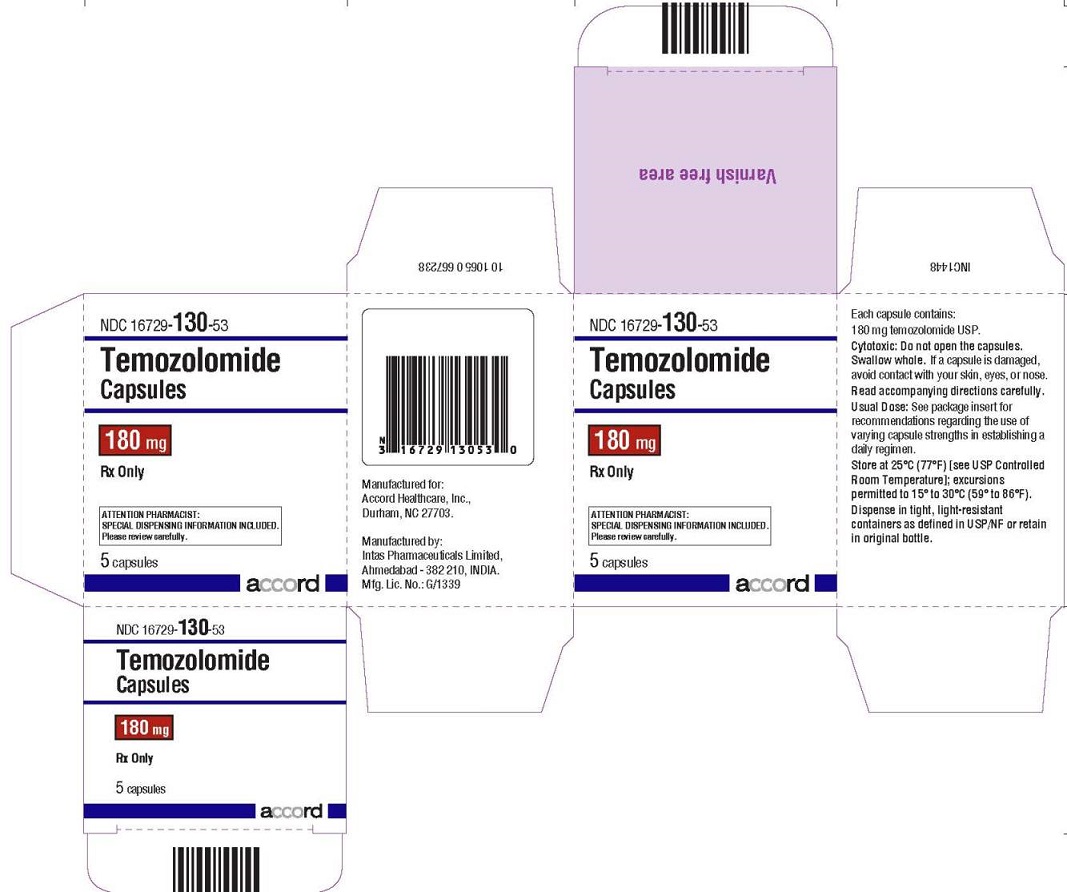
Principal Display Panel- 250 mg Capsules
Amber Glass Bottle Carton
NDC 16729- 051-53
Temozolamide
Capsules250 mg
Rx only
5 capsules
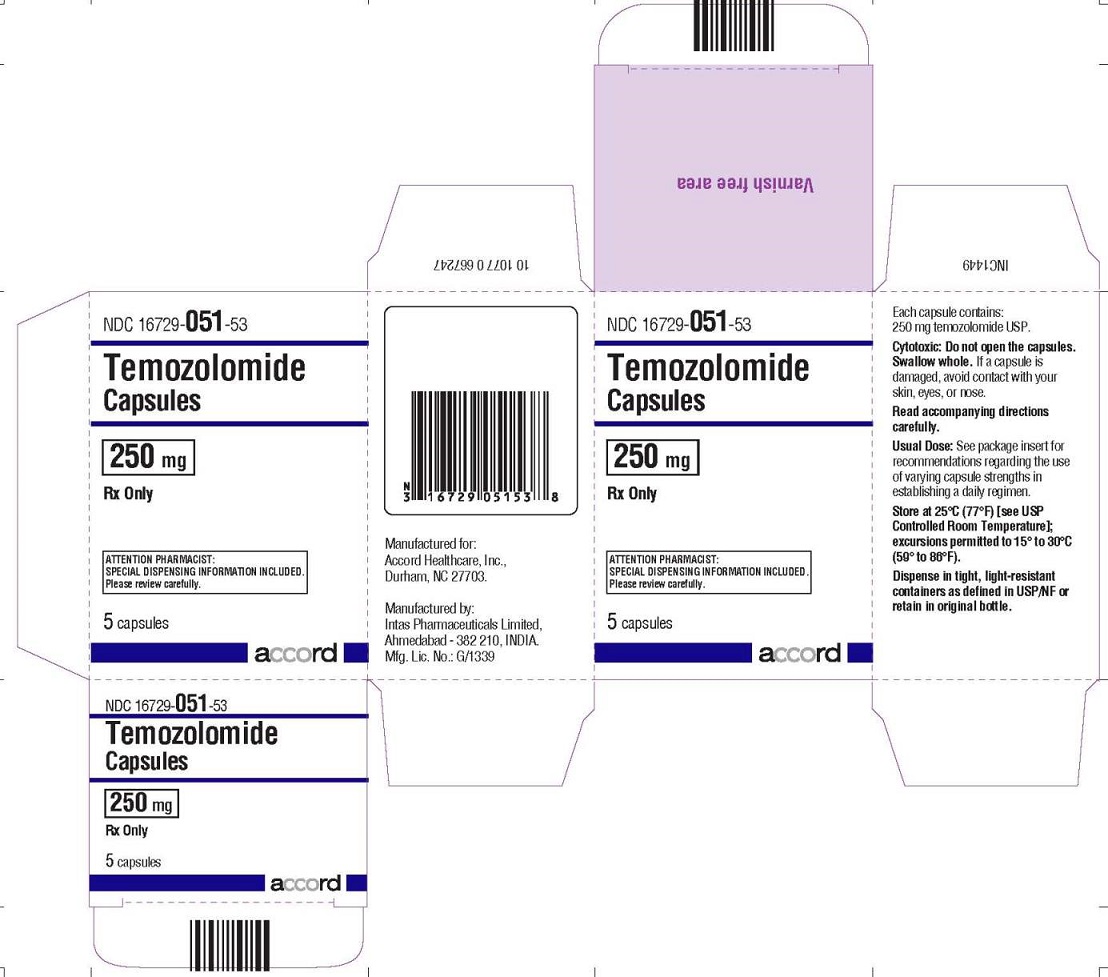
Principal Display Panel- 5 mg Capsules
Sachet Pack Carton
NDC 16729- 048-31
Temozolamide
Capsules5 mg
Rx only
THIS PACKAGE CONTAINS 5 INDIVIDUAL SACHETS
Each Individual Sachet Contains One Capsule Each
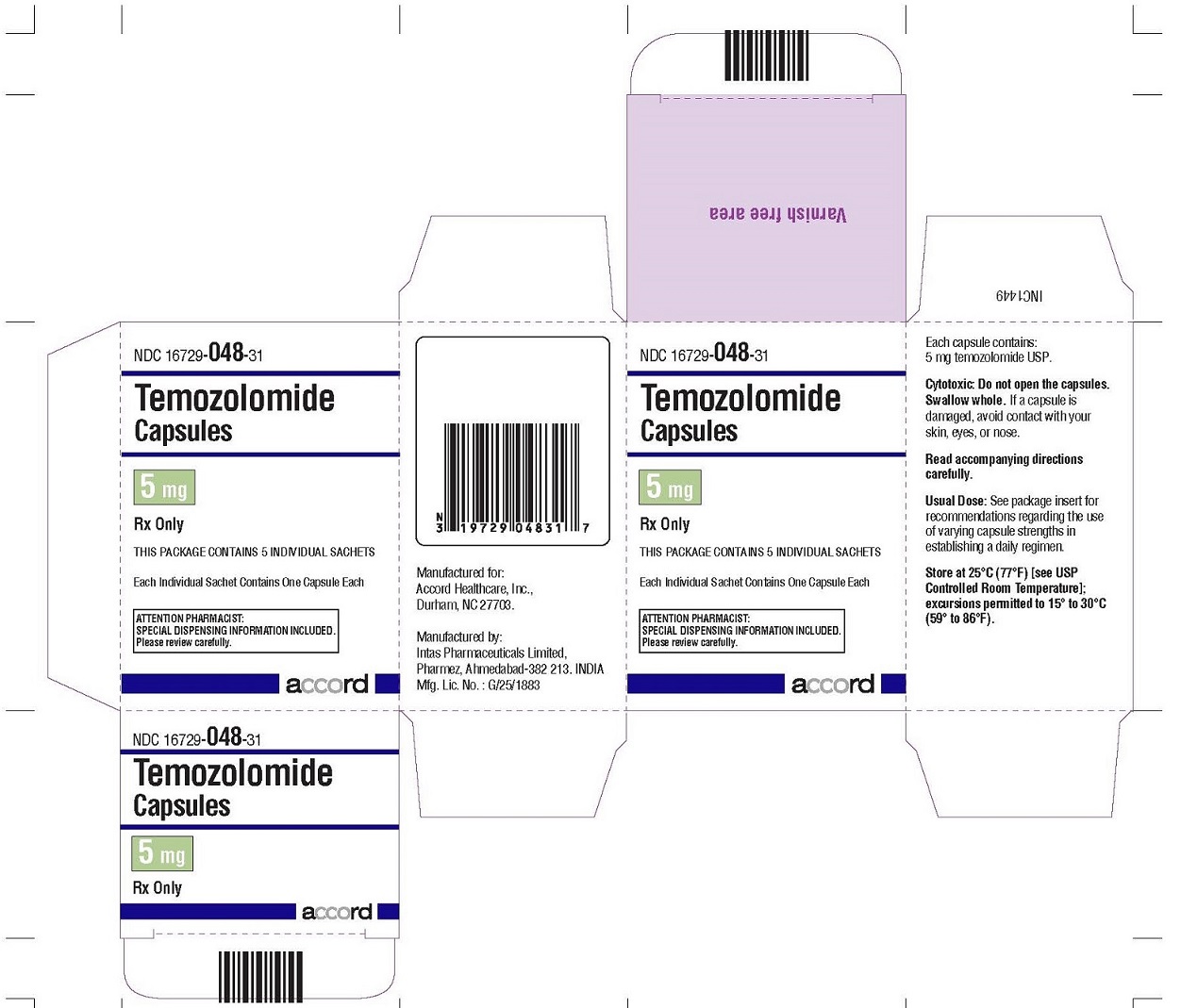
Principal Display Panel- 20 mg Capsules
Sachet Pack Carton
NDC 16729- 049-31
Temozolamide
Capsules20 mg
Rx only
THIS PACKAGE CONTAINS 5 INDIVIDUAL SACHETS
Each Individual Sachet Contains One Capsule Each
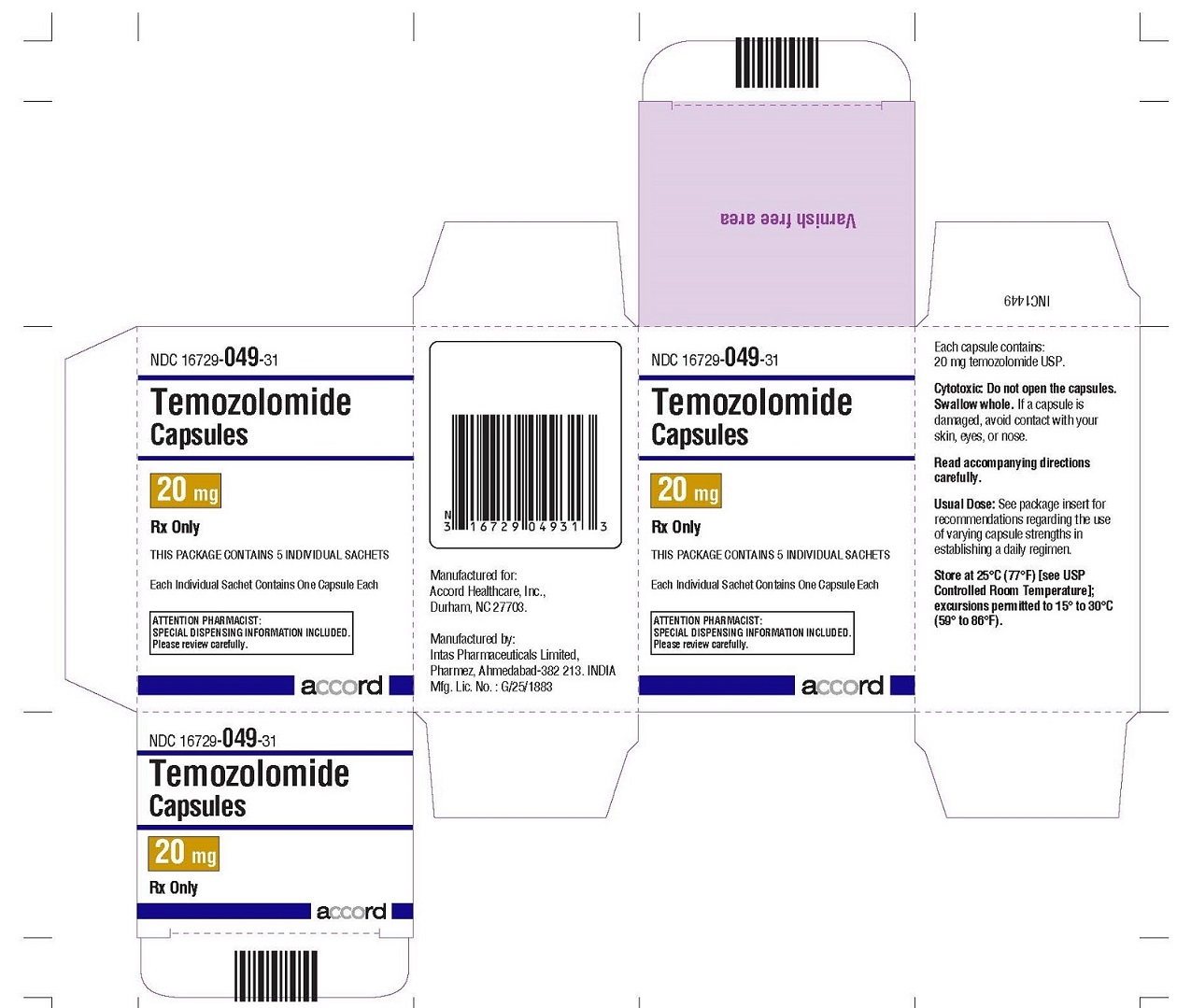
Principal Display Panel- 100 mg Capsules
Sachet Pack Carton
NDC 16729- 050-31
Temozolamide
Capsules100 mg
Rx only
THIS PACKAGE CONTAINS 5 INDIVIDUAL SACHETS
Each Individual Sachet Contains One Capsule Each

Principal Display Panel- 140 mg Capsules
Sachet Pack Carton
NDC 16729- 129-31
Temozolamide
Capsules140 mg
Rx only
THIS PACKAGE CONTAINS 5 INDIVIDUAL SACHETS
Each Individual Sachet Contains One Capsule Each
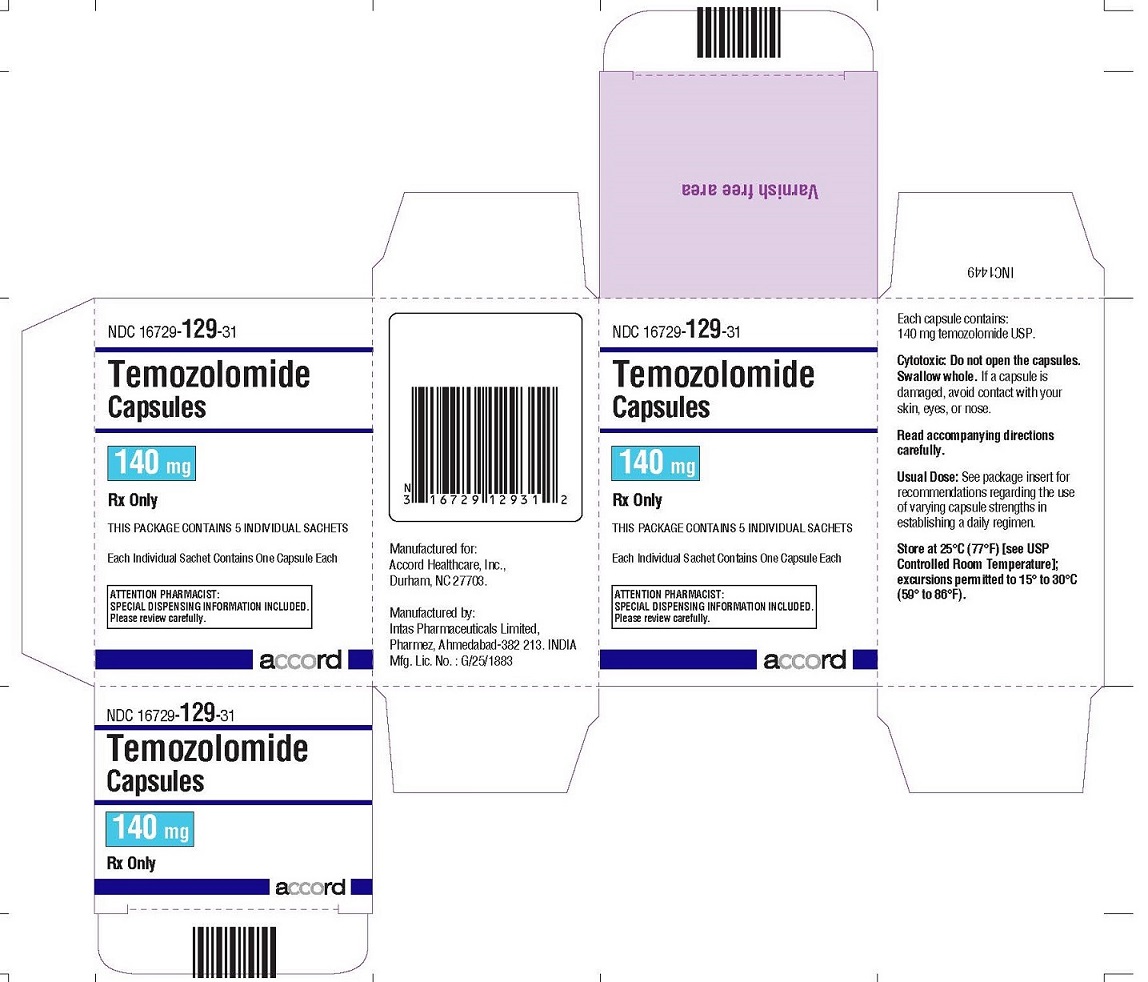
Principal Display Panel- 180 mg Capsules
Sachet Pack Carton
NDC 16729- 130-31
Temozolamide
Capsules180 mg
Rx only
THIS PACKAGE CONTAINS 5 INDIVIDUAL SACHETS
Each Individual Sachet Contains One Capsule Each
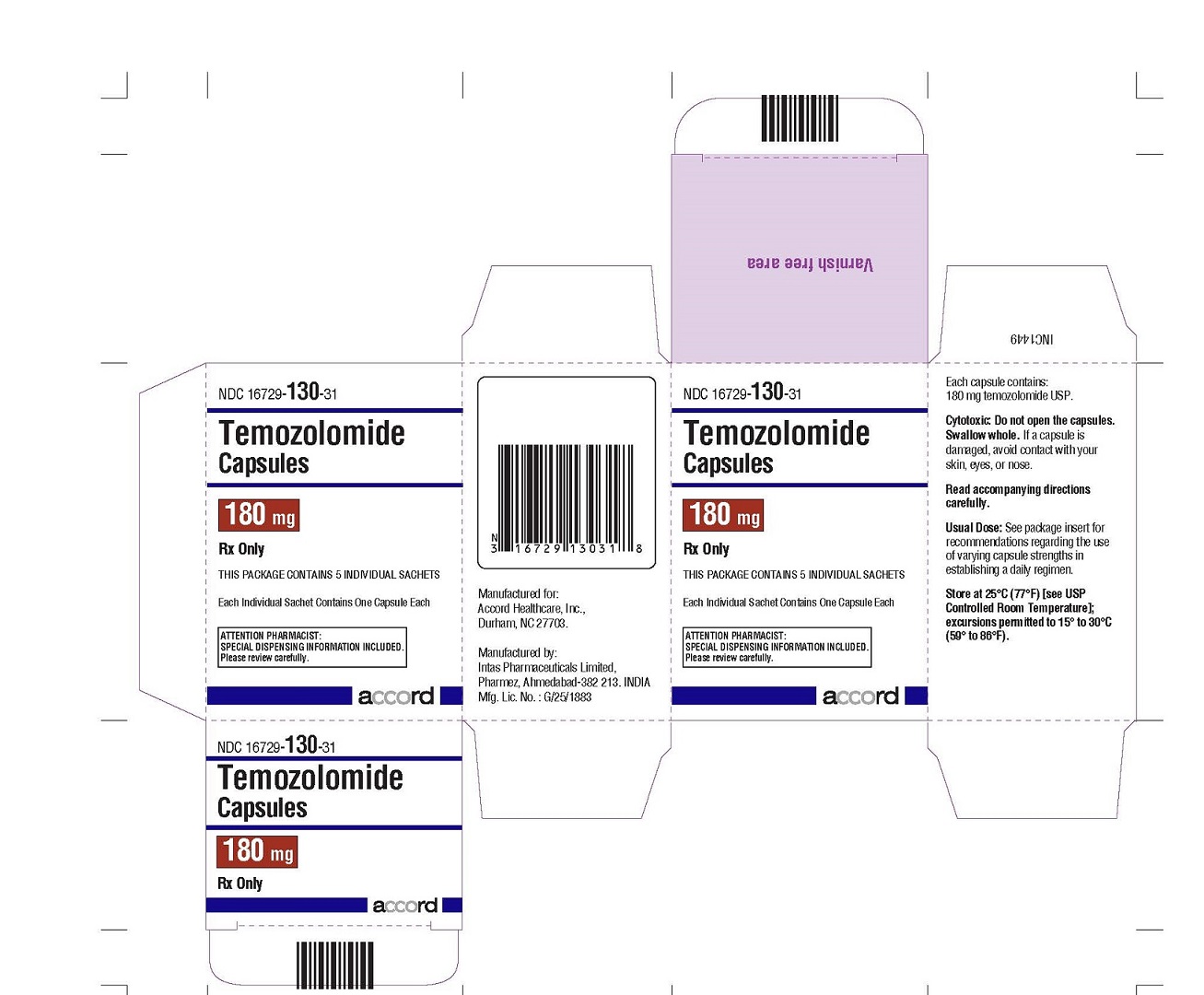
Principal Display Panel- 250 mg Capsules
Sachet Pack Carton
NDC 16729- 051-31
Temozolamide
Capsules250 mg
Rx only
THIS PACKAGE CONTAINS 5 INDIVIDUAL SACHETS
Each Individual Sachet Contains One Capsule Each
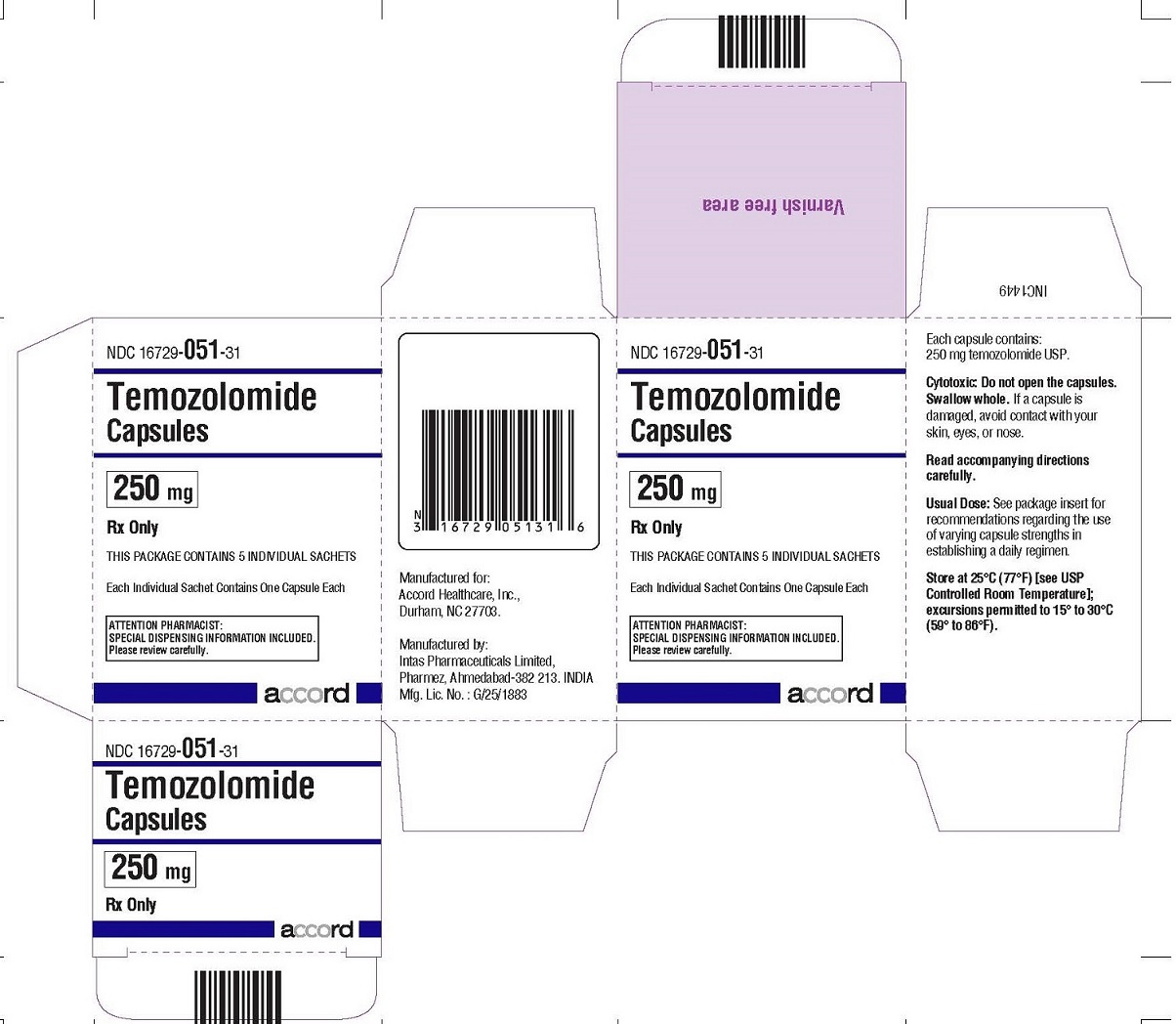
-
INGREDIENTS AND APPEARANCE
TEMOZOLOMIDE
temozolomide capsuleProduct Information Product Type HUMAN PRESCRIPTION DRUG Item Code (Source) NDC: 16729-048 Route of Administration ORAL Active Ingredient/Active Moiety Ingredient Name Basis of Strength Strength TEMOZOLOMIDE (UNII: YF1K15M17Y) (TEMOZOLOMIDE - UNII:YF1K15M17Y) TEMOZOLOMIDE 5 mg Inactive Ingredients Ingredient Name Strength ANHYDROUS LACTOSE (UNII: 3SY5LH9PMK) SILICON DIOXIDE (UNII: ETJ7Z6XBU4) SODIUM STARCH GLYCOLATE TYPE A POTATO (UNII: 5856J3G2A2) TARTARIC ACID (UNII: W4888I119H) STEARIC ACID (UNII: 4ELV7Z65AP) FERRIC OXIDE RED (UNII: 1K09F3G675) GELATIN (UNII: 2G86QN327L) TITANIUM DIOXIDE (UNII: 15FIX9V2JP) FERRIC OXIDE YELLOW (UNII: EX438O2MRT) FD&C BLUE NO. 2 (UNII: L06K8R7DQK) SHELLAC (UNII: 46N107B71O) POTASSIUM HYDROXIDE (UNII: WZH3C48M4T) FERROSOFERRIC OXIDE (UNII: XM0M87F357) Product Characteristics Color green, white Score no score Shape CAPSULE Size 9mm Flavor Imprint Code 5;TMZ Contains Packaging # Item Code Package Description Marketing Start Date Marketing End Date 1 NDC: 16729-048-53 1 in 1 CARTON 03/07/2017 1 5 in 1 BOTTLE, GLASS; Type 0: Not a Combination Product 2 NDC: 16729-048-54 1 in 1 CARTON 03/07/2017 2 14 in 1 BOTTLE, GLASS; Type 0: Not a Combination Product 3 NDC: 16729-048-31 5 in 1 CARTON 11/20/2024 3 1 in 1 POUCH; Type 0: Not a Combination Product 4 NDC: 16729-048-04 14 in 1 CARTON 11/20/2024 4 1 in 1 POUCH; Type 0: Not a Combination Product Marketing Information Marketing Category Application Number or Monograph Citation Marketing Start Date Marketing End Date ANDA ANDA201528 03/07/2017 TEMOZOLOMIDE
temozolomide capsuleProduct Information Product Type HUMAN PRESCRIPTION DRUG Item Code (Source) NDC: 16729-049 Route of Administration ORAL Active Ingredient/Active Moiety Ingredient Name Basis of Strength Strength TEMOZOLOMIDE (UNII: YF1K15M17Y) (TEMOZOLOMIDE - UNII:YF1K15M17Y) TEMOZOLOMIDE 20 mg Inactive Ingredients Ingredient Name Strength ANHYDROUS LACTOSE (UNII: 3SY5LH9PMK) SILICON DIOXIDE (UNII: ETJ7Z6XBU4) SODIUM STARCH GLYCOLATE TYPE A POTATO (UNII: 5856J3G2A2) TARTARIC ACID (UNII: W4888I119H) STEARIC ACID (UNII: 4ELV7Z65AP) FERRIC OXIDE RED (UNII: 1K09F3G675) GELATIN (UNII: 2G86QN327L) TITANIUM DIOXIDE (UNII: 15FIX9V2JP) FERRIC OXIDE YELLOW (UNII: EX438O2MRT) SHELLAC (UNII: 46N107B71O) POTASSIUM HYDROXIDE (UNII: WZH3C48M4T) FERROSOFERRIC OXIDE (UNII: XM0M87F357) Product Characteristics Color yellow, white Score no score Shape CAPSULE Size 9mm Flavor Imprint Code 20;TMZ Contains Packaging # Item Code Package Description Marketing Start Date Marketing End Date 1 NDC: 16729-049-53 1 in 1 CARTON 03/07/2017 1 5 in 1 BOTTLE, GLASS; Type 0: Not a Combination Product 2 NDC: 16729-049-54 1 in 1 CARTON 06/13/2017 2 14 in 1 BOTTLE, GLASS; Type 0: Not a Combination Product 3 NDC: 16729-049-31 5 in 1 CARTON 11/20/2024 3 1 in 1 POUCH; Type 0: Not a Combination Product 4 NDC: 16729-049-04 14 in 1 CARTON 11/20/2024 4 1 in 1 POUCH; Type 0: Not a Combination Product Marketing Information Marketing Category Application Number or Monograph Citation Marketing Start Date Marketing End Date ANDA ANDA201528 03/07/2017 TEMOZOLOMIDE
temozolomide capsuleProduct Information Product Type HUMAN PRESCRIPTION DRUG Item Code (Source) NDC: 16729-050 Route of Administration ORAL Active Ingredient/Active Moiety Ingredient Name Basis of Strength Strength TEMOZOLOMIDE (UNII: YF1K15M17Y) (TEMOZOLOMIDE - UNII:YF1K15M17Y) TEMOZOLOMIDE 100 mg Inactive Ingredients Ingredient Name Strength ANHYDROUS LACTOSE (UNII: 3SY5LH9PMK) SILICON DIOXIDE (UNII: ETJ7Z6XBU4) SODIUM STARCH GLYCOLATE TYPE A POTATO (UNII: 5856J3G2A2) TARTARIC ACID (UNII: W4888I119H) STEARIC ACID (UNII: 4ELV7Z65AP) FERRIC OXIDE RED (UNII: 1K09F3G675) GELATIN (UNII: 2G86QN327L) TITANIUM DIOXIDE (UNII: 15FIX9V2JP) SHELLAC (UNII: 46N107B71O) POTASSIUM HYDROXIDE (UNII: WZH3C48M4T) FERROSOFERRIC OXIDE (UNII: XM0M87F357) Product Characteristics Color pink, white Score no score Shape CAPSULE Size 9mm Flavor Imprint Code 100;TMZ Contains Packaging # Item Code Package Description Marketing Start Date Marketing End Date 1 NDC: 16729-050-53 1 in 1 CARTON 03/07/2017 1 5 in 1 BOTTLE, GLASS; Type 0: Not a Combination Product 2 NDC: 16729-050-54 1 in 1 CARTON 03/07/2017 2 14 in 1 BOTTLE, GLASS; Type 0: Not a Combination Product 3 NDC: 16729-050-31 5 in 1 CARTON 11/20/2024 3 1 in 1 POUCH; Type 0: Not a Combination Product 4 NDC: 16729-050-04 14 in 1 CARTON 11/20/2024 4 1 in 1 POUCH; Type 0: Not a Combination Product Marketing Information Marketing Category Application Number or Monograph Citation Marketing Start Date Marketing End Date ANDA ANDA201528 03/07/2017 TEMOZOLOMIDE
temozolomide capsuleProduct Information Product Type HUMAN PRESCRIPTION DRUG Item Code (Source) NDC: 16729-129 Route of Administration ORAL Active Ingredient/Active Moiety Ingredient Name Basis of Strength Strength TEMOZOLOMIDE (UNII: YF1K15M17Y) (TEMOZOLOMIDE - UNII:YF1K15M17Y) TEMOZOLOMIDE 140 mg Inactive Ingredients Ingredient Name Strength ANHYDROUS LACTOSE (UNII: 3SY5LH9PMK) SILICON DIOXIDE (UNII: ETJ7Z6XBU4) SODIUM STARCH GLYCOLATE TYPE A POTATO (UNII: 5856J3G2A2) TARTARIC ACID (UNII: W4888I119H) STEARIC ACID (UNII: 4ELV7Z65AP) GELATIN (UNII: 2G86QN327L) TITANIUM DIOXIDE (UNII: 15FIX9V2JP) FD&C BLUE NO. 2 (UNII: L06K8R7DQK) SHELLAC (UNII: 46N107B71O) POTASSIUM HYDROXIDE (UNII: WZH3C48M4T) FERROSOFERRIC OXIDE (UNII: XM0M87F357) Product Characteristics Color blue, white Score no score Shape CAPSULE Size 9mm Flavor Imprint Code 140;TMZ Contains Packaging # Item Code Package Description Marketing Start Date Marketing End Date 1 NDC: 16729-129-53 1 in 1 CARTON 03/07/2017 1 5 in 1 BOTTLE, GLASS; Type 0: Not a Combination Product 2 NDC: 16729-129-54 1 in 1 CARTON 03/07/2017 2 14 in 1 BOTTLE, GLASS; Type 0: Not a Combination Product 3 NDC: 16729-129-31 5 in 1 CARTON 11/20/2024 3 1 in 1 POUCH; Type 0: Not a Combination Product 4 NDC: 16729-129-04 14 in 1 CARTON 11/20/2024 4 1 in 1 POUCH; Type 0: Not a Combination Product Marketing Information Marketing Category Application Number or Monograph Citation Marketing Start Date Marketing End Date ANDA ANDA201528 03/07/2017 TEMOZOLOMIDE
temozolomide capsuleProduct Information Product Type HUMAN PRESCRIPTION DRUG Item Code (Source) NDC: 16729-130 Route of Administration ORAL Active Ingredient/Active Moiety Ingredient Name Basis of Strength Strength TEMOZOLOMIDE (UNII: YF1K15M17Y) (TEMOZOLOMIDE - UNII:YF1K15M17Y) TEMOZOLOMIDE 180 mg Inactive Ingredients Ingredient Name Strength ANHYDROUS LACTOSE (UNII: 3SY5LH9PMK) SILICON DIOXIDE (UNII: ETJ7Z6XBU4) SODIUM STARCH GLYCOLATE TYPE A POTATO (UNII: 5856J3G2A2) TARTARIC ACID (UNII: W4888I119H) STEARIC ACID (UNII: 4ELV7Z65AP) FERRIC OXIDE RED (UNII: 1K09F3G675) GELATIN (UNII: 2G86QN327L) TITANIUM DIOXIDE (UNII: 15FIX9V2JP) FERRIC OXIDE YELLOW (UNII: EX438O2MRT) SHELLAC (UNII: 46N107B71O) POTASSIUM HYDROXIDE (UNII: WZH3C48M4T) FERROSOFERRIC OXIDE (UNII: XM0M87F357) Product Characteristics Color orange (maroon) , white Score no score Shape CAPSULE Size 9mm Flavor Imprint Code 180;TMZ Contains Packaging # Item Code Package Description Marketing Start Date Marketing End Date 1 NDC: 16729-130-53 1 in 1 CARTON 03/07/2017 1 5 in 1 BOTTLE, GLASS; Type 0: Not a Combination Product 2 NDC: 16729-130-54 1 in 1 CARTON 03/07/2017 2 14 in 1 BOTTLE, GLASS; Type 0: Not a Combination Product 3 NDC: 16729-130-31 5 in 1 CARTON 11/20/2024 3 1 in 1 POUCH; Type 0: Not a Combination Product 4 NDC: 16729-130-04 14 in 1 CARTON 11/20/2024 4 1 in 1 POUCH; Type 0: Not a Combination Product Marketing Information Marketing Category Application Number or Monograph Citation Marketing Start Date Marketing End Date ANDA ANDA201528 03/07/2017 TEMOZOLOMIDE
temozolomide capsuleProduct Information Product Type HUMAN PRESCRIPTION DRUG Item Code (Source) NDC: 16729-051 Route of Administration ORAL Active Ingredient/Active Moiety Ingredient Name Basis of Strength Strength TEMOZOLOMIDE (UNII: YF1K15M17Y) (TEMOZOLOMIDE - UNII:YF1K15M17Y) TEMOZOLOMIDE 250 mg Inactive Ingredients Ingredient Name Strength ANHYDROUS LACTOSE (UNII: 3SY5LH9PMK) SILICON DIOXIDE (UNII: ETJ7Z6XBU4) SODIUM STARCH GLYCOLATE TYPE A POTATO (UNII: 5856J3G2A2) TARTARIC ACID (UNII: W4888I119H) STEARIC ACID (UNII: 4ELV7Z65AP) GELATIN (UNII: 2G86QN327L) TITANIUM DIOXIDE (UNII: 15FIX9V2JP) SODIUM LAURYL SULFATE (UNII: 368GB5141J) SHELLAC (UNII: 46N107B71O) POTASSIUM HYDROXIDE (UNII: WZH3C48M4T) FERROSOFERRIC OXIDE (UNII: XM0M87F357) Product Characteristics Color white, white Score no score Shape CAPSULE Size 9mm Flavor Imprint Code 250;TMZ Contains Packaging # Item Code Package Description Marketing Start Date Marketing End Date 1 NDC: 16729-051-53 1 in 1 CARTON 03/07/2017 1 5 in 1 BOTTLE, GLASS; Type 0: Not a Combination Product 2 NDC: 16729-051-31 5 in 1 CARTON 11/20/2024 2 1 in 1 POUCH; Type 0: Not a Combination Product Marketing Information Marketing Category Application Number or Monograph Citation Marketing Start Date Marketing End Date ANDA ANDA201528 03/07/2017 Labeler - Accord Healthcare Inc. (604222237) Registrant - Accord Healthcare Inc. (604222237) Establishment Name Address ID/FEI Business Operations Intas Pharmaceuticals Limited 725927649 manufacture(16729-048, 16729-049, 16729-050, 16729-129, 16729-130, 16729-051) , analysis(16729-048, 16729-049, 16729-050, 16729-129, 16729-130, 16729-051) Establishment Name Address ID/FEI Business Operations Intas Pharmaceuticals Limited 915837971 manufacture(16729-048, 16729-049, 16729-050, 16729-129, 16729-130, 16729-051) , analysis(16729-048, 16729-049, 16729-050, 16729-129, 16729-130, 16729-051)
© 2025 FDA.report
This site is not affiliated with or endorsed by the FDA.
